Return to Work after Brain Injury: A Comparative Study
VerifiedAdded on 2021/04/24
|29
|7592
|41
AI Summary
This assignment delves into the complexities of return to work after acquired brain injury, comparing the job tasks, functions, and knowledge domains of rehabilitation professionals providing vocational rehabilitation services in Australia and Germany. It also examines general practitioners' sickness certification for injury in Australia, workplace mental health training for managers and its effect on sick leave in employees, return to work practices and research with spinal cord injury from an Australian perspective, return to work outcomes for workers with mental health conditions, employer policies and practices to manage and prevent disability, and the impact of precarious employment on occupational safety and health.
Contribute Materials
Your contribution can guide someone’s learning journey. Share your
documents today.

Running head: REHABILITATION
Rehabilitation
Name of the student:
Name of the university:
Author note:
Rehabilitation
Name of the student:
Name of the university:
Author note:
Secure Best Marks with AI Grader
Need help grading? Try our AI Grader for instant feedback on your assignments.
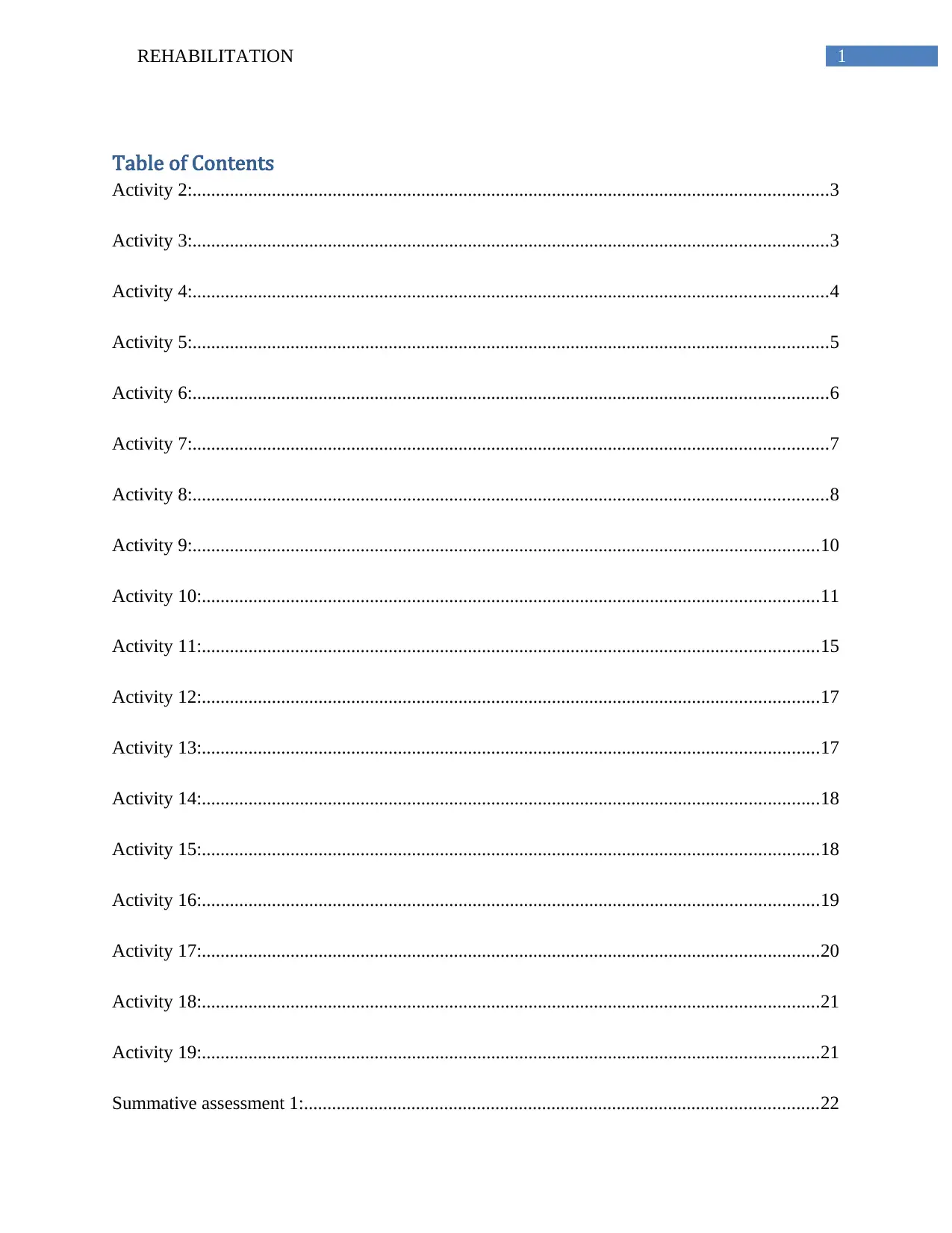
1REHABILITATION
Table of Contents
Activity 2:........................................................................................................................................3
Activity 3:........................................................................................................................................3
Activity 4:........................................................................................................................................4
Activity 5:........................................................................................................................................5
Activity 6:........................................................................................................................................6
Activity 7:........................................................................................................................................7
Activity 8:........................................................................................................................................8
Activity 9:......................................................................................................................................10
Activity 10:....................................................................................................................................11
Activity 11:....................................................................................................................................15
Activity 12:....................................................................................................................................17
Activity 13:....................................................................................................................................17
Activity 14:....................................................................................................................................18
Activity 15:....................................................................................................................................18
Activity 16:....................................................................................................................................19
Activity 17:....................................................................................................................................20
Activity 18:....................................................................................................................................21
Activity 19:....................................................................................................................................21
Summative assessment 1:..............................................................................................................22
Table of Contents
Activity 2:........................................................................................................................................3
Activity 3:........................................................................................................................................3
Activity 4:........................................................................................................................................4
Activity 5:........................................................................................................................................5
Activity 6:........................................................................................................................................6
Activity 7:........................................................................................................................................7
Activity 8:........................................................................................................................................8
Activity 9:......................................................................................................................................10
Activity 10:....................................................................................................................................11
Activity 11:....................................................................................................................................15
Activity 12:....................................................................................................................................17
Activity 13:....................................................................................................................................17
Activity 14:....................................................................................................................................18
Activity 15:....................................................................................................................................18
Activity 16:....................................................................................................................................19
Activity 17:....................................................................................................................................20
Activity 18:....................................................................................................................................21
Activity 19:....................................................................................................................................21
Summative assessment 1:..............................................................................................................22
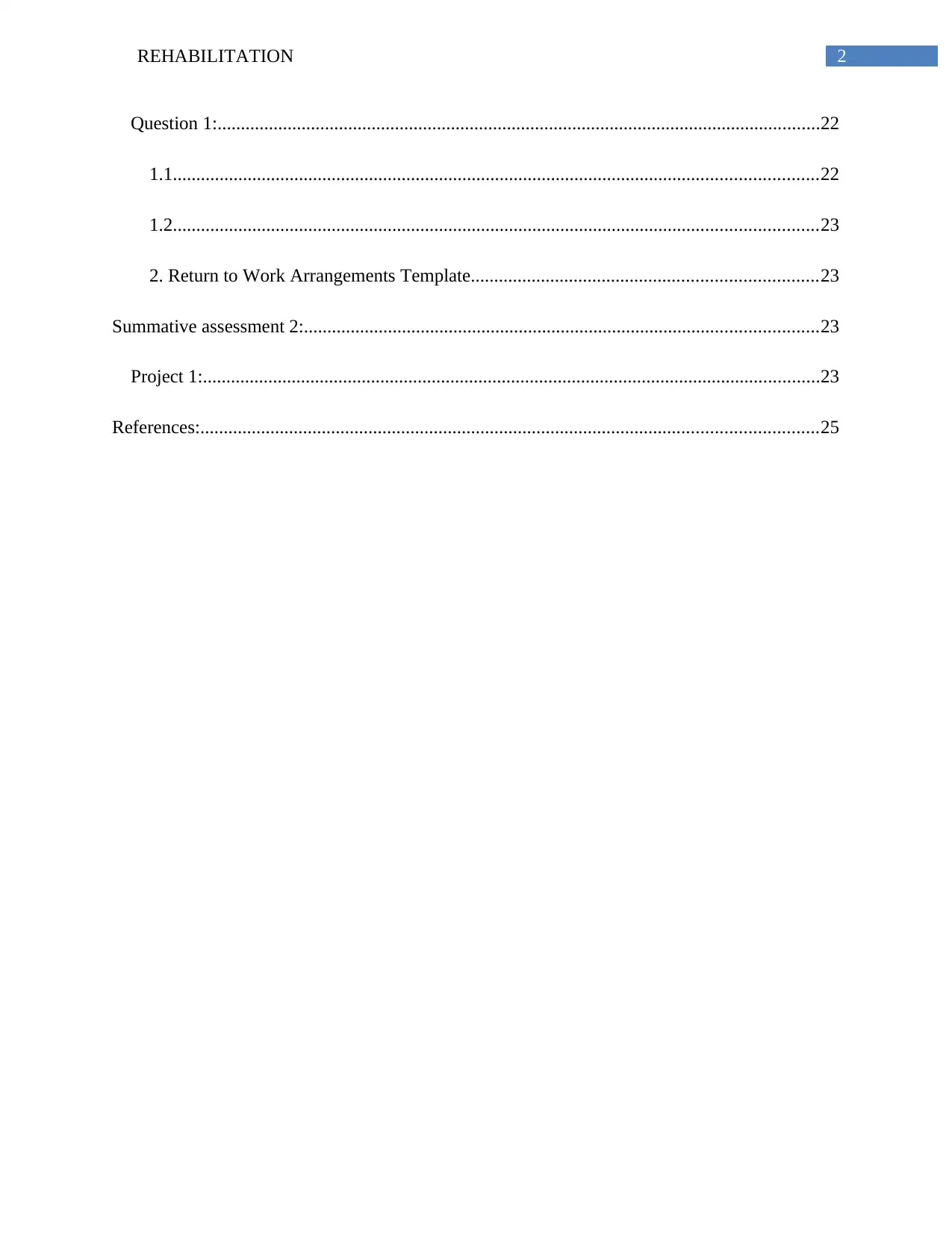
2REHABILITATION
Question 1:.................................................................................................................................22
1.1..........................................................................................................................................22
1.2..........................................................................................................................................23
2. Return to Work Arrangements Template..........................................................................23
Summative assessment 2:..............................................................................................................23
Project 1:....................................................................................................................................23
References:....................................................................................................................................25
Question 1:.................................................................................................................................22
1.1..........................................................................................................................................22
1.2..........................................................................................................................................23
2. Return to Work Arrangements Template..........................................................................23
Summative assessment 2:..............................................................................................................23
Project 1:....................................................................................................................................23
References:....................................................................................................................................25
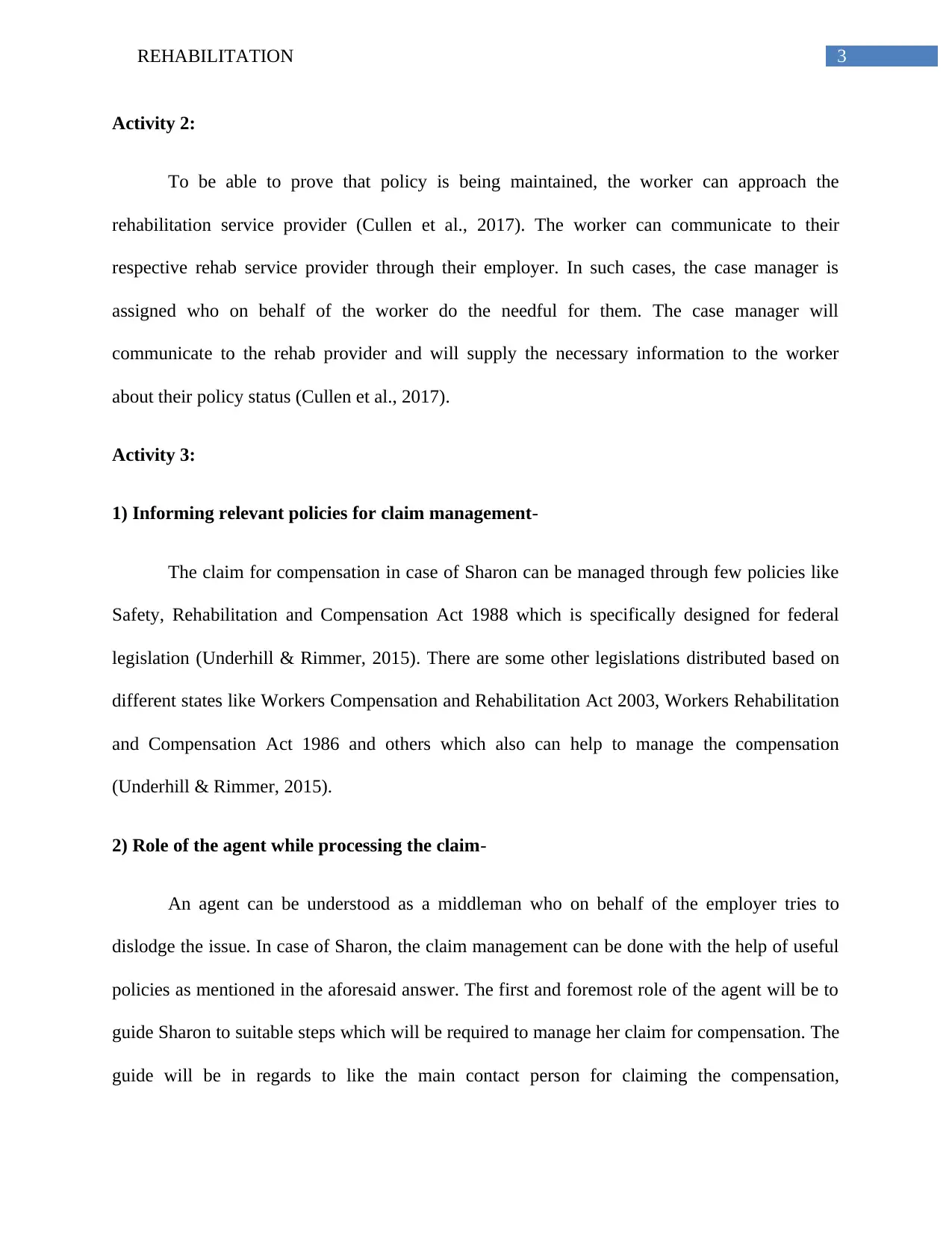
3REHABILITATION
Activity 2:
To be able to prove that policy is being maintained, the worker can approach the
rehabilitation service provider (Cullen et al., 2017). The worker can communicate to their
respective rehab service provider through their employer. In such cases, the case manager is
assigned who on behalf of the worker do the needful for them. The case manager will
communicate to the rehab provider and will supply the necessary information to the worker
about their policy status (Cullen et al., 2017).
Activity 3:
1) Informing relevant policies for claim management-
The claim for compensation in case of Sharon can be managed through few policies like
Safety, Rehabilitation and Compensation Act 1988 which is specifically designed for federal
legislation (Underhill & Rimmer, 2015). There are some other legislations distributed based on
different states like Workers Compensation and Rehabilitation Act 2003, Workers Rehabilitation
and Compensation Act 1986 and others which also can help to manage the compensation
(Underhill & Rimmer, 2015).
2) Role of the agent while processing the claim-
An agent can be understood as a middleman who on behalf of the employer tries to
dislodge the issue. In case of Sharon, the claim management can be done with the help of useful
policies as mentioned in the aforesaid answer. The first and foremost role of the agent will be to
guide Sharon to suitable steps which will be required to manage her claim for compensation. The
guide will be in regards to like the main contact person for claiming the compensation,
Activity 2:
To be able to prove that policy is being maintained, the worker can approach the
rehabilitation service provider (Cullen et al., 2017). The worker can communicate to their
respective rehab service provider through their employer. In such cases, the case manager is
assigned who on behalf of the worker do the needful for them. The case manager will
communicate to the rehab provider and will supply the necessary information to the worker
about their policy status (Cullen et al., 2017).
Activity 3:
1) Informing relevant policies for claim management-
The claim for compensation in case of Sharon can be managed through few policies like
Safety, Rehabilitation and Compensation Act 1988 which is specifically designed for federal
legislation (Underhill & Rimmer, 2015). There are some other legislations distributed based on
different states like Workers Compensation and Rehabilitation Act 2003, Workers Rehabilitation
and Compensation Act 1986 and others which also can help to manage the compensation
(Underhill & Rimmer, 2015).
2) Role of the agent while processing the claim-
An agent can be understood as a middleman who on behalf of the employer tries to
dislodge the issue. In case of Sharon, the claim management can be done with the help of useful
policies as mentioned in the aforesaid answer. The first and foremost role of the agent will be to
guide Sharon to suitable steps which will be required to manage her claim for compensation. The
guide will be in regards to like the main contact person for claiming the compensation,
Secure Best Marks with AI Grader
Need help grading? Try our AI Grader for instant feedback on your assignments.
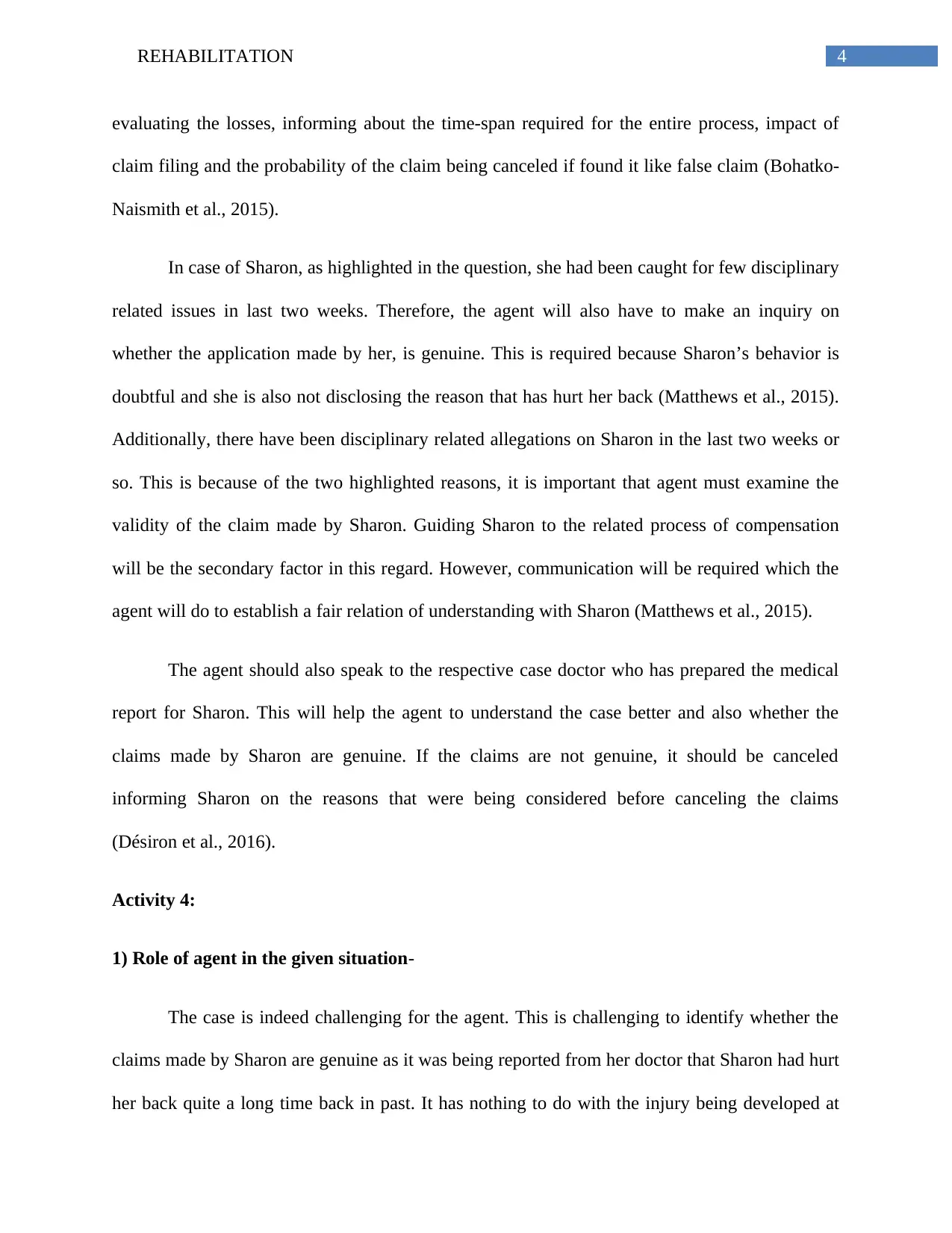
4REHABILITATION
evaluating the losses, informing about the time-span required for the entire process, impact of
claim filing and the probability of the claim being canceled if found it like false claim (Bohatko-
Naismith et al., 2015).
In case of Sharon, as highlighted in the question, she had been caught for few disciplinary
related issues in last two weeks. Therefore, the agent will also have to make an inquiry on
whether the application made by her, is genuine. This is required because Sharon’s behavior is
doubtful and she is also not disclosing the reason that has hurt her back (Matthews et al., 2015).
Additionally, there have been disciplinary related allegations on Sharon in the last two weeks or
so. This is because of the two highlighted reasons, it is important that agent must examine the
validity of the claim made by Sharon. Guiding Sharon to the related process of compensation
will be the secondary factor in this regard. However, communication will be required which the
agent will do to establish a fair relation of understanding with Sharon (Matthews et al., 2015).
The agent should also speak to the respective case doctor who has prepared the medical
report for Sharon. This will help the agent to understand the case better and also whether the
claims made by Sharon are genuine. If the claims are not genuine, it should be canceled
informing Sharon on the reasons that were being considered before canceling the claims
(Désiron et al., 2016).
Activity 4:
1) Role of agent in the given situation-
The case is indeed challenging for the agent. This is challenging to identify whether the
claims made by Sharon are genuine as it was being reported from her doctor that Sharon had hurt
her back quite a long time back in past. It has nothing to do with the injury being developed at
evaluating the losses, informing about the time-span required for the entire process, impact of
claim filing and the probability of the claim being canceled if found it like false claim (Bohatko-
Naismith et al., 2015).
In case of Sharon, as highlighted in the question, she had been caught for few disciplinary
related issues in last two weeks. Therefore, the agent will also have to make an inquiry on
whether the application made by her, is genuine. This is required because Sharon’s behavior is
doubtful and she is also not disclosing the reason that has hurt her back (Matthews et al., 2015).
Additionally, there have been disciplinary related allegations on Sharon in the last two weeks or
so. This is because of the two highlighted reasons, it is important that agent must examine the
validity of the claim made by Sharon. Guiding Sharon to the related process of compensation
will be the secondary factor in this regard. However, communication will be required which the
agent will do to establish a fair relation of understanding with Sharon (Matthews et al., 2015).
The agent should also speak to the respective case doctor who has prepared the medical
report for Sharon. This will help the agent to understand the case better and also whether the
claims made by Sharon are genuine. If the claims are not genuine, it should be canceled
informing Sharon on the reasons that were being considered before canceling the claims
(Désiron et al., 2016).
Activity 4:
1) Role of agent in the given situation-
The case is indeed challenging for the agent. This is challenging to identify whether the
claims made by Sharon are genuine as it was being reported from her doctor that Sharon had hurt
her back quite a long time back in past. It has nothing to do with the injury being developed at
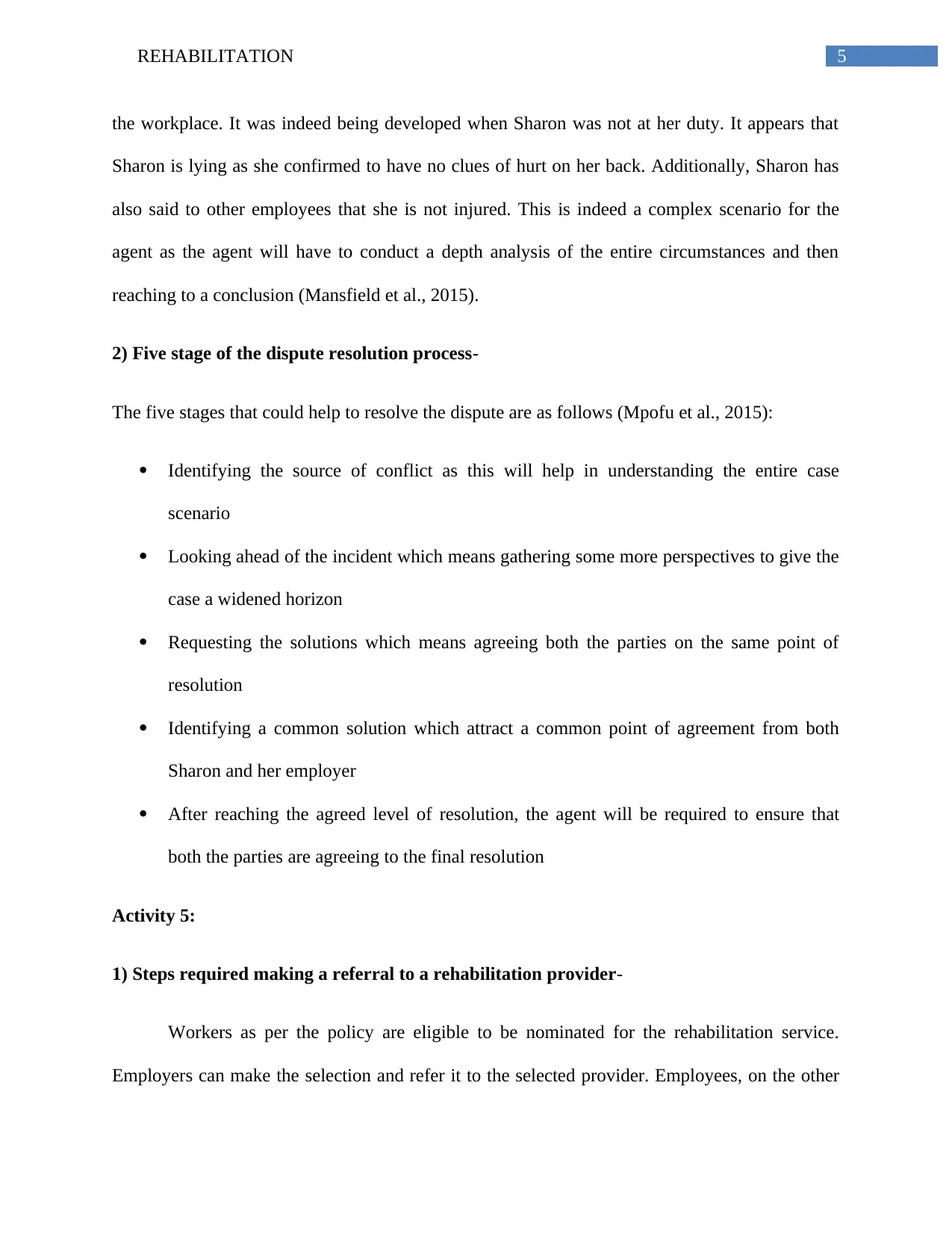
5REHABILITATION
the workplace. It was indeed being developed when Sharon was not at her duty. It appears that
Sharon is lying as she confirmed to have no clues of hurt on her back. Additionally, Sharon has
also said to other employees that she is not injured. This is indeed a complex scenario for the
agent as the agent will have to conduct a depth analysis of the entire circumstances and then
reaching to a conclusion (Mansfield et al., 2015).
2) Five stage of the dispute resolution process-
The five stages that could help to resolve the dispute are as follows (Mpofu et al., 2015):
Identifying the source of conflict as this will help in understanding the entire case
scenario
Looking ahead of the incident which means gathering some more perspectives to give the
case a widened horizon
Requesting the solutions which means agreeing both the parties on the same point of
resolution
Identifying a common solution which attract a common point of agreement from both
Sharon and her employer
After reaching the agreed level of resolution, the agent will be required to ensure that
both the parties are agreeing to the final resolution
Activity 5:
1) Steps required making a referral to a rehabilitation provider-
Workers as per the policy are eligible to be nominated for the rehabilitation service.
Employers can make the selection and refer it to the selected provider. Employees, on the other
the workplace. It was indeed being developed when Sharon was not at her duty. It appears that
Sharon is lying as she confirmed to have no clues of hurt on her back. Additionally, Sharon has
also said to other employees that she is not injured. This is indeed a complex scenario for the
agent as the agent will have to conduct a depth analysis of the entire circumstances and then
reaching to a conclusion (Mansfield et al., 2015).
2) Five stage of the dispute resolution process-
The five stages that could help to resolve the dispute are as follows (Mpofu et al., 2015):
Identifying the source of conflict as this will help in understanding the entire case
scenario
Looking ahead of the incident which means gathering some more perspectives to give the
case a widened horizon
Requesting the solutions which means agreeing both the parties on the same point of
resolution
Identifying a common solution which attract a common point of agreement from both
Sharon and her employer
After reaching the agreed level of resolution, the agent will be required to ensure that
both the parties are agreeing to the final resolution
Activity 5:
1) Steps required making a referral to a rehabilitation provider-
Workers as per the policy are eligible to be nominated for the rehabilitation service.
Employers can make the selection and refer it to the selected provider. Employees, on the other
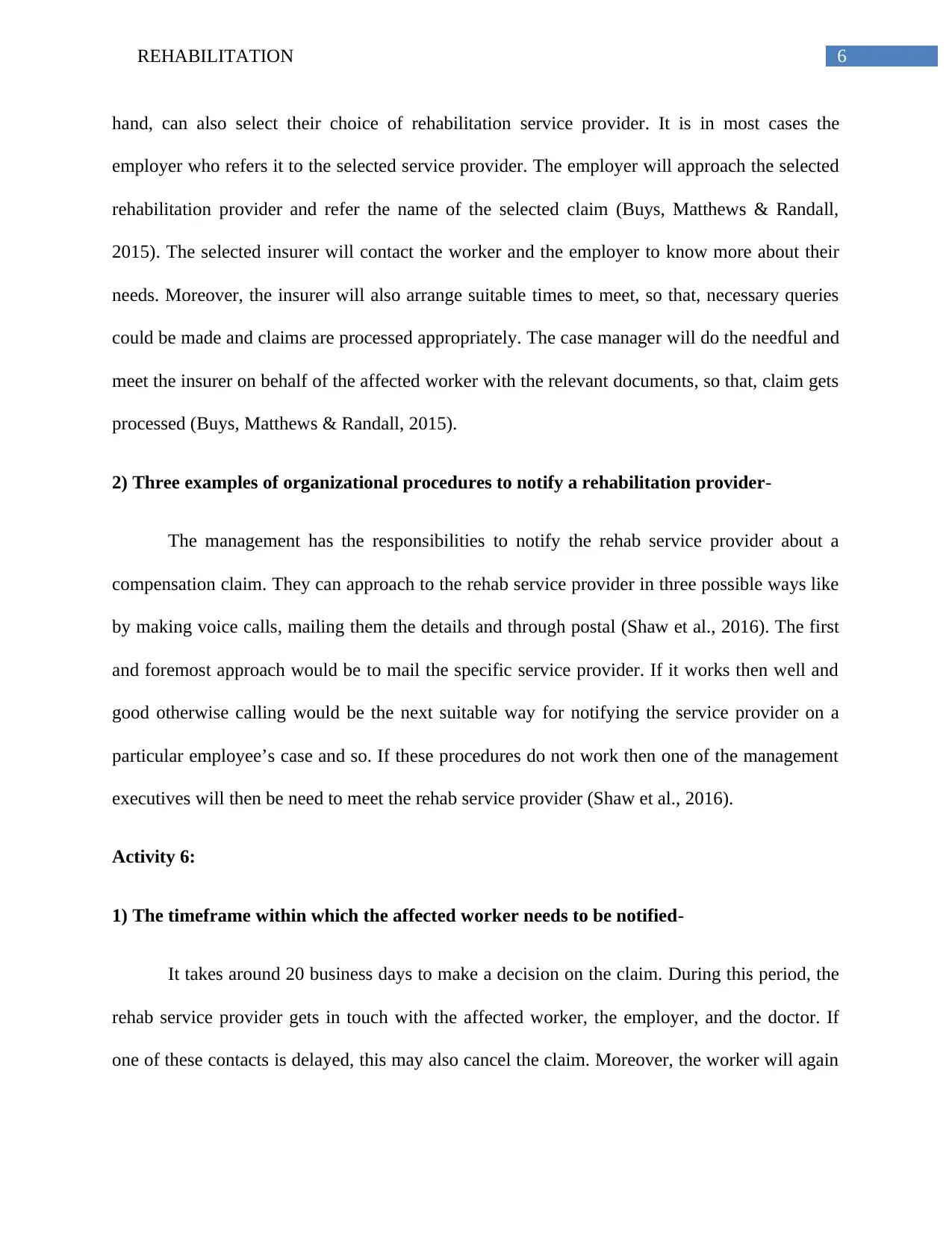
6REHABILITATION
hand, can also select their choice of rehabilitation service provider. It is in most cases the
employer who refers it to the selected service provider. The employer will approach the selected
rehabilitation provider and refer the name of the selected claim (Buys, Matthews & Randall,
2015). The selected insurer will contact the worker and the employer to know more about their
needs. Moreover, the insurer will also arrange suitable times to meet, so that, necessary queries
could be made and claims are processed appropriately. The case manager will do the needful and
meet the insurer on behalf of the affected worker with the relevant documents, so that, claim gets
processed (Buys, Matthews & Randall, 2015).
2) Three examples of organizational procedures to notify a rehabilitation provider-
The management has the responsibilities to notify the rehab service provider about a
compensation claim. They can approach to the rehab service provider in three possible ways like
by making voice calls, mailing them the details and through postal (Shaw et al., 2016). The first
and foremost approach would be to mail the specific service provider. If it works then well and
good otherwise calling would be the next suitable way for notifying the service provider on a
particular employee’s case and so. If these procedures do not work then one of the management
executives will then be need to meet the rehab service provider (Shaw et al., 2016).
Activity 6:
1) The timeframe within which the affected worker needs to be notified-
It takes around 20 business days to make a decision on the claim. During this period, the
rehab service provider gets in touch with the affected worker, the employer, and the doctor. If
one of these contacts is delayed, this may also cancel the claim. Moreover, the worker will again
hand, can also select their choice of rehabilitation service provider. It is in most cases the
employer who refers it to the selected service provider. The employer will approach the selected
rehabilitation provider and refer the name of the selected claim (Buys, Matthews & Randall,
2015). The selected insurer will contact the worker and the employer to know more about their
needs. Moreover, the insurer will also arrange suitable times to meet, so that, necessary queries
could be made and claims are processed appropriately. The case manager will do the needful and
meet the insurer on behalf of the affected worker with the relevant documents, so that, claim gets
processed (Buys, Matthews & Randall, 2015).
2) Three examples of organizational procedures to notify a rehabilitation provider-
The management has the responsibilities to notify the rehab service provider about a
compensation claim. They can approach to the rehab service provider in three possible ways like
by making voice calls, mailing them the details and through postal (Shaw et al., 2016). The first
and foremost approach would be to mail the specific service provider. If it works then well and
good otherwise calling would be the next suitable way for notifying the service provider on a
particular employee’s case and so. If these procedures do not work then one of the management
executives will then be need to meet the rehab service provider (Shaw et al., 2016).
Activity 6:
1) The timeframe within which the affected worker needs to be notified-
It takes around 20 business days to make a decision on the claim. During this period, the
rehab service provider gets in touch with the affected worker, the employer, and the doctor. If
one of these contacts is delayed, this may also cancel the claim. Moreover, the worker will again
Paraphrase This Document
Need a fresh take? Get an instant paraphrase of this document with our AI Paraphraser
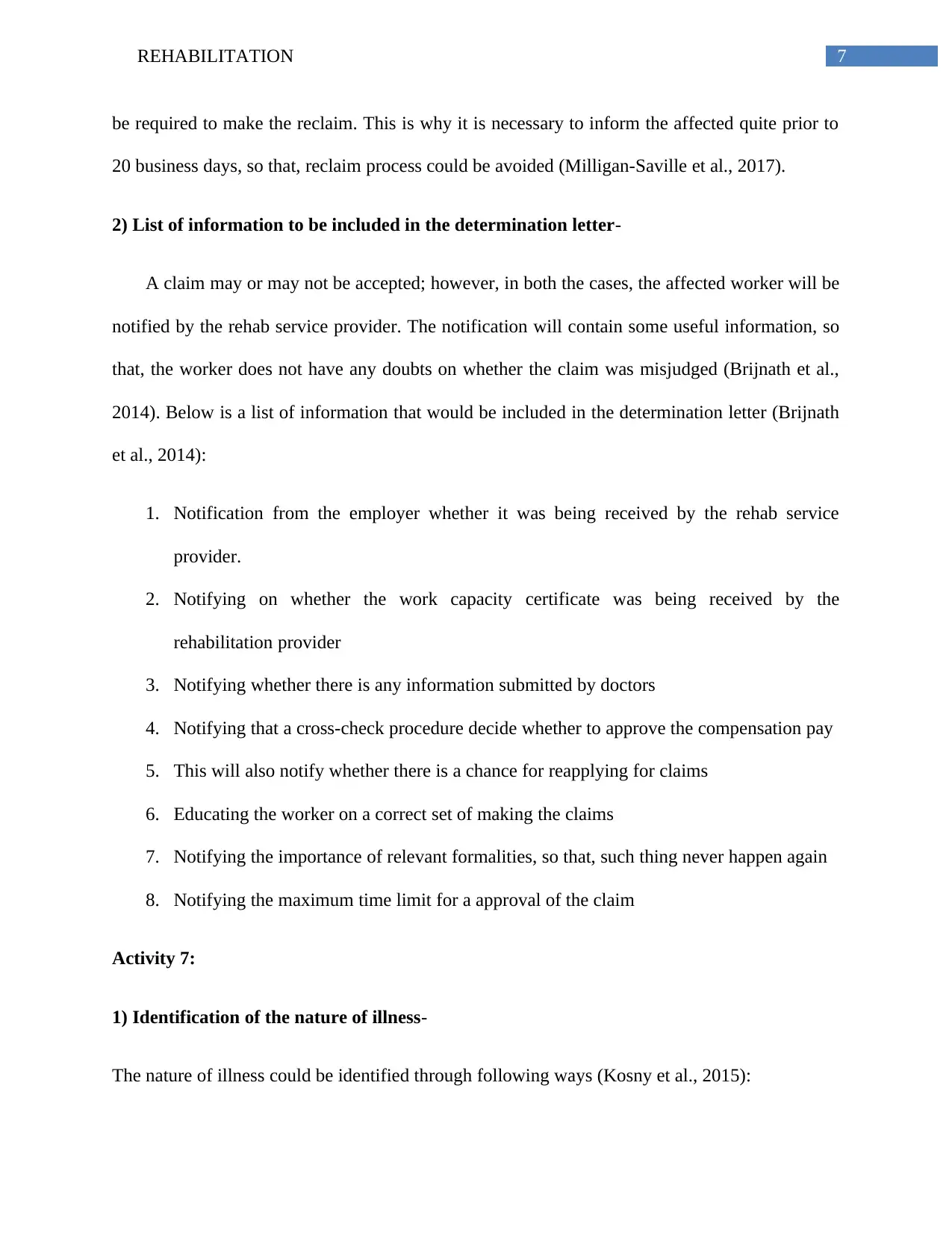
7REHABILITATION
be required to make the reclaim. This is why it is necessary to inform the affected quite prior to
20 business days, so that, reclaim process could be avoided (Milligan-Saville et al., 2017).
2) List of information to be included in the determination letter-
A claim may or may not be accepted; however, in both the cases, the affected worker will be
notified by the rehab service provider. The notification will contain some useful information, so
that, the worker does not have any doubts on whether the claim was misjudged (Brijnath et al.,
2014). Below is a list of information that would be included in the determination letter (Brijnath
et al., 2014):
1. Notification from the employer whether it was being received by the rehab service
provider.
2. Notifying on whether the work capacity certificate was being received by the
rehabilitation provider
3. Notifying whether there is any information submitted by doctors
4. Notifying that a cross-check procedure decide whether to approve the compensation pay
5. This will also notify whether there is a chance for reapplying for claims
6. Educating the worker on a correct set of making the claims
7. Notifying the importance of relevant formalities, so that, such thing never happen again
8. Notifying the maximum time limit for a approval of the claim
Activity 7:
1) Identification of the nature of illness-
The nature of illness could be identified through following ways (Kosny et al., 2015):
be required to make the reclaim. This is why it is necessary to inform the affected quite prior to
20 business days, so that, reclaim process could be avoided (Milligan-Saville et al., 2017).
2) List of information to be included in the determination letter-
A claim may or may not be accepted; however, in both the cases, the affected worker will be
notified by the rehab service provider. The notification will contain some useful information, so
that, the worker does not have any doubts on whether the claim was misjudged (Brijnath et al.,
2014). Below is a list of information that would be included in the determination letter (Brijnath
et al., 2014):
1. Notification from the employer whether it was being received by the rehab service
provider.
2. Notifying on whether the work capacity certificate was being received by the
rehabilitation provider
3. Notifying whether there is any information submitted by doctors
4. Notifying that a cross-check procedure decide whether to approve the compensation pay
5. This will also notify whether there is a chance for reapplying for claims
6. Educating the worker on a correct set of making the claims
7. Notifying the importance of relevant formalities, so that, such thing never happen again
8. Notifying the maximum time limit for a approval of the claim
Activity 7:
1) Identification of the nature of illness-
The nature of illness could be identified through following ways (Kosny et al., 2015):
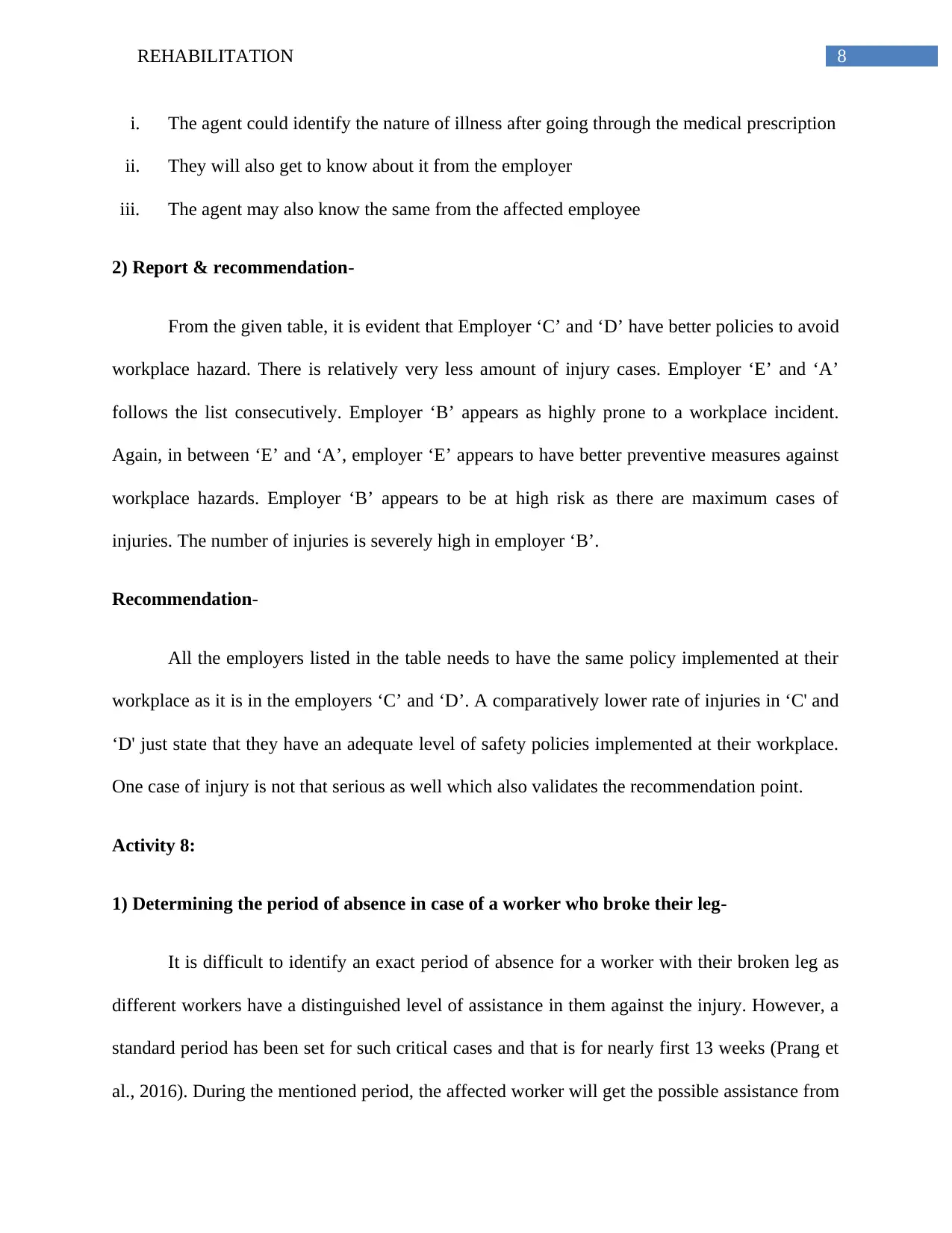
8REHABILITATION
i. The agent could identify the nature of illness after going through the medical prescription
ii. They will also get to know about it from the employer
iii. The agent may also know the same from the affected employee
2) Report & recommendation-
From the given table, it is evident that Employer ‘C’ and ‘D’ have better policies to avoid
workplace hazard. There is relatively very less amount of injury cases. Employer ‘E’ and ‘A’
follows the list consecutively. Employer ‘B’ appears as highly prone to a workplace incident.
Again, in between ‘E’ and ‘A’, employer ‘E’ appears to have better preventive measures against
workplace hazards. Employer ‘B’ appears to be at high risk as there are maximum cases of
injuries. The number of injuries is severely high in employer ‘B’.
Recommendation-
All the employers listed in the table needs to have the same policy implemented at their
workplace as it is in the employers ‘C’ and ‘D’. A comparatively lower rate of injuries in ‘C' and
‘D' just state that they have an adequate level of safety policies implemented at their workplace.
One case of injury is not that serious as well which also validates the recommendation point.
Activity 8:
1) Determining the period of absence in case of a worker who broke their leg-
It is difficult to identify an exact period of absence for a worker with their broken leg as
different workers have a distinguished level of assistance in them against the injury. However, a
standard period has been set for such critical cases and that is for nearly first 13 weeks (Prang et
al., 2016). During the mentioned period, the affected worker will get the possible assistance from
i. The agent could identify the nature of illness after going through the medical prescription
ii. They will also get to know about it from the employer
iii. The agent may also know the same from the affected employee
2) Report & recommendation-
From the given table, it is evident that Employer ‘C’ and ‘D’ have better policies to avoid
workplace hazard. There is relatively very less amount of injury cases. Employer ‘E’ and ‘A’
follows the list consecutively. Employer ‘B’ appears as highly prone to a workplace incident.
Again, in between ‘E’ and ‘A’, employer ‘E’ appears to have better preventive measures against
workplace hazards. Employer ‘B’ appears to be at high risk as there are maximum cases of
injuries. The number of injuries is severely high in employer ‘B’.
Recommendation-
All the employers listed in the table needs to have the same policy implemented at their
workplace as it is in the employers ‘C’ and ‘D’. A comparatively lower rate of injuries in ‘C' and
‘D' just state that they have an adequate level of safety policies implemented at their workplace.
One case of injury is not that serious as well which also validates the recommendation point.
Activity 8:
1) Determining the period of absence in case of a worker who broke their leg-
It is difficult to identify an exact period of absence for a worker with their broken leg as
different workers have a distinguished level of assistance in them against the injury. However, a
standard period has been set for such critical cases and that is for nearly first 13 weeks (Prang et
al., 2016). During the mentioned period, the affected worker will get the possible assistance from
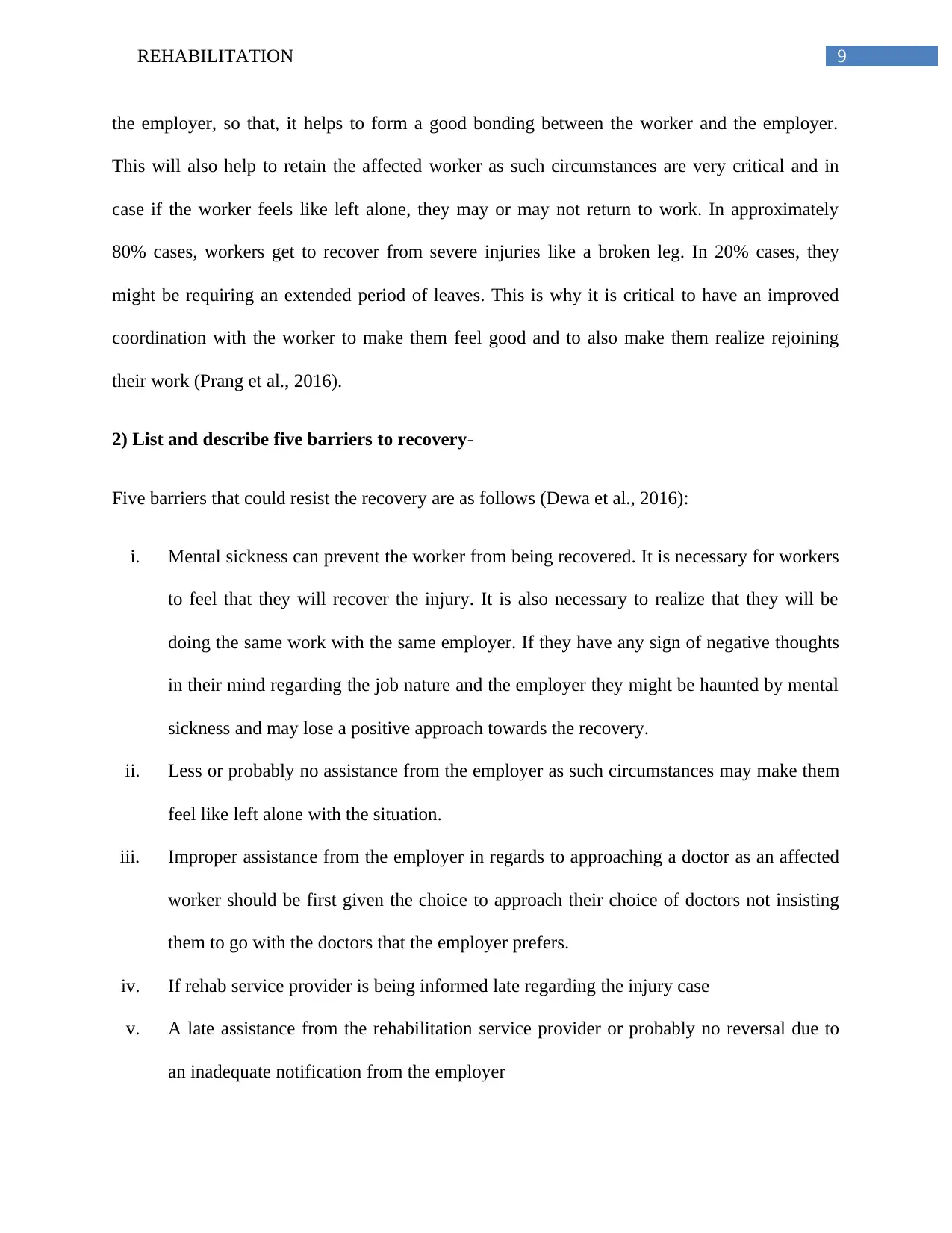
9REHABILITATION
the employer, so that, it helps to form a good bonding between the worker and the employer.
This will also help to retain the affected worker as such circumstances are very critical and in
case if the worker feels like left alone, they may or may not return to work. In approximately
80% cases, workers get to recover from severe injuries like a broken leg. In 20% cases, they
might be requiring an extended period of leaves. This is why it is critical to have an improved
coordination with the worker to make them feel good and to also make them realize rejoining
their work (Prang et al., 2016).
2) List and describe five barriers to recovery-
Five barriers that could resist the recovery are as follows (Dewa et al., 2016):
i. Mental sickness can prevent the worker from being recovered. It is necessary for workers
to feel that they will recover the injury. It is also necessary to realize that they will be
doing the same work with the same employer. If they have any sign of negative thoughts
in their mind regarding the job nature and the employer they might be haunted by mental
sickness and may lose a positive approach towards the recovery.
ii. Less or probably no assistance from the employer as such circumstances may make them
feel like left alone with the situation.
iii. Improper assistance from the employer in regards to approaching a doctor as an affected
worker should be first given the choice to approach their choice of doctors not insisting
them to go with the doctors that the employer prefers.
iv. If rehab service provider is being informed late regarding the injury case
v. A late assistance from the rehabilitation service provider or probably no reversal due to
an inadequate notification from the employer
the employer, so that, it helps to form a good bonding between the worker and the employer.
This will also help to retain the affected worker as such circumstances are very critical and in
case if the worker feels like left alone, they may or may not return to work. In approximately
80% cases, workers get to recover from severe injuries like a broken leg. In 20% cases, they
might be requiring an extended period of leaves. This is why it is critical to have an improved
coordination with the worker to make them feel good and to also make them realize rejoining
their work (Prang et al., 2016).
2) List and describe five barriers to recovery-
Five barriers that could resist the recovery are as follows (Dewa et al., 2016):
i. Mental sickness can prevent the worker from being recovered. It is necessary for workers
to feel that they will recover the injury. It is also necessary to realize that they will be
doing the same work with the same employer. If they have any sign of negative thoughts
in their mind regarding the job nature and the employer they might be haunted by mental
sickness and may lose a positive approach towards the recovery.
ii. Less or probably no assistance from the employer as such circumstances may make them
feel like left alone with the situation.
iii. Improper assistance from the employer in regards to approaching a doctor as an affected
worker should be first given the choice to approach their choice of doctors not insisting
them to go with the doctors that the employer prefers.
iv. If rehab service provider is being informed late regarding the injury case
v. A late assistance from the rehabilitation service provider or probably no reversal due to
an inadequate notification from the employer
Secure Best Marks with AI Grader
Need help grading? Try our AI Grader for instant feedback on your assignments.
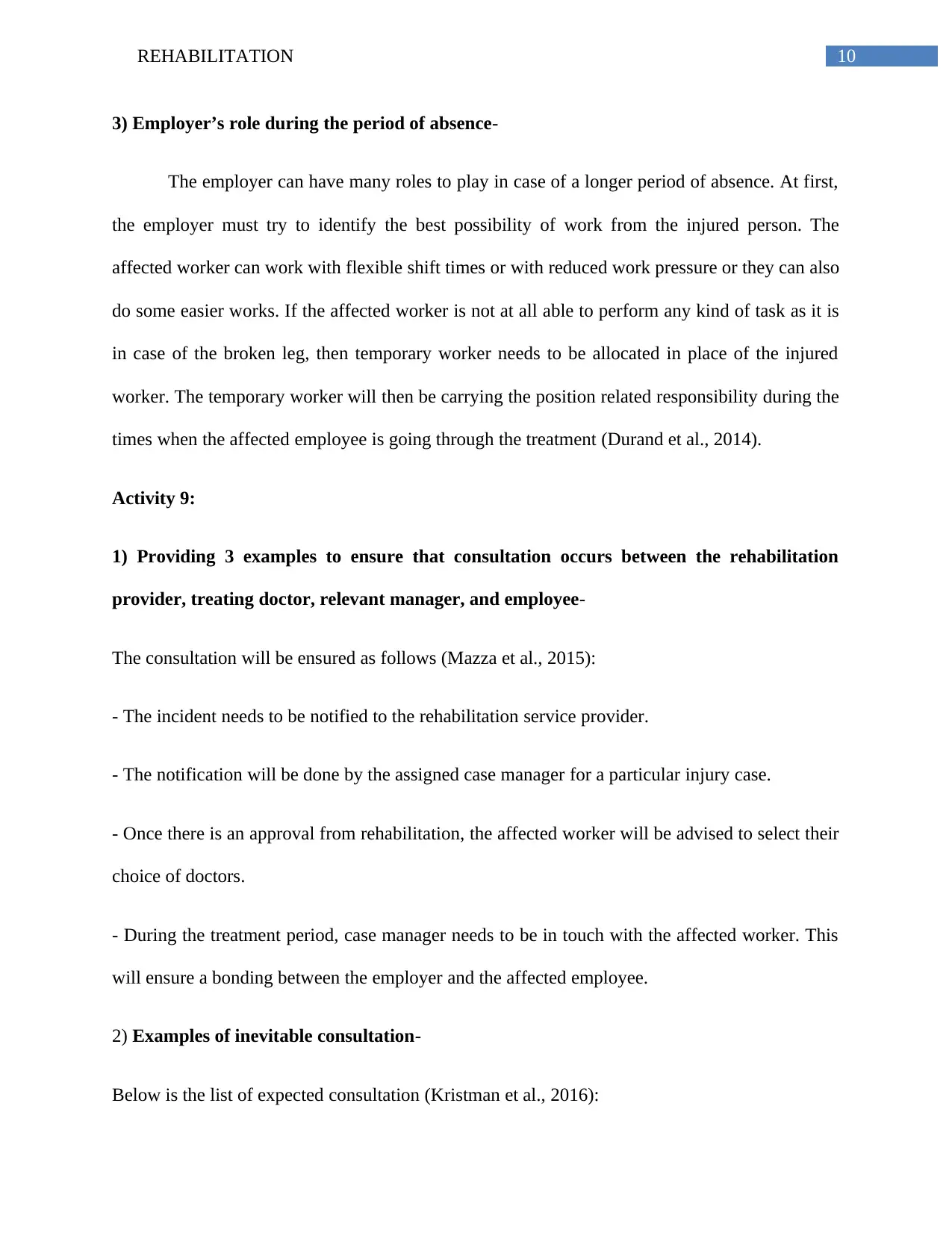
10REHABILITATION
3) Employer’s role during the period of absence-
The employer can have many roles to play in case of a longer period of absence. At first,
the employer must try to identify the best possibility of work from the injured person. The
affected worker can work with flexible shift times or with reduced work pressure or they can also
do some easier works. If the affected worker is not at all able to perform any kind of task as it is
in case of the broken leg, then temporary worker needs to be allocated in place of the injured
worker. The temporary worker will then be carrying the position related responsibility during the
times when the affected employee is going through the treatment (Durand et al., 2014).
Activity 9:
1) Providing 3 examples to ensure that consultation occurs between the rehabilitation
provider, treating doctor, relevant manager, and employee-
The consultation will be ensured as follows (Mazza et al., 2015):
- The incident needs to be notified to the rehabilitation service provider.
- The notification will be done by the assigned case manager for a particular injury case.
- Once there is an approval from rehabilitation, the affected worker will be advised to select their
choice of doctors.
- During the treatment period, case manager needs to be in touch with the affected worker. This
will ensure a bonding between the employer and the affected employee.
2) Examples of inevitable consultation-
Below is the list of expected consultation (Kristman et al., 2016):
3) Employer’s role during the period of absence-
The employer can have many roles to play in case of a longer period of absence. At first,
the employer must try to identify the best possibility of work from the injured person. The
affected worker can work with flexible shift times or with reduced work pressure or they can also
do some easier works. If the affected worker is not at all able to perform any kind of task as it is
in case of the broken leg, then temporary worker needs to be allocated in place of the injured
worker. The temporary worker will then be carrying the position related responsibility during the
times when the affected employee is going through the treatment (Durand et al., 2014).
Activity 9:
1) Providing 3 examples to ensure that consultation occurs between the rehabilitation
provider, treating doctor, relevant manager, and employee-
The consultation will be ensured as follows (Mazza et al., 2015):
- The incident needs to be notified to the rehabilitation service provider.
- The notification will be done by the assigned case manager for a particular injury case.
- Once there is an approval from rehabilitation, the affected worker will be advised to select their
choice of doctors.
- During the treatment period, case manager needs to be in touch with the affected worker. This
will ensure a bonding between the employer and the affected employee.
2) Examples of inevitable consultation-
Below is the list of expected consultation (Kristman et al., 2016):
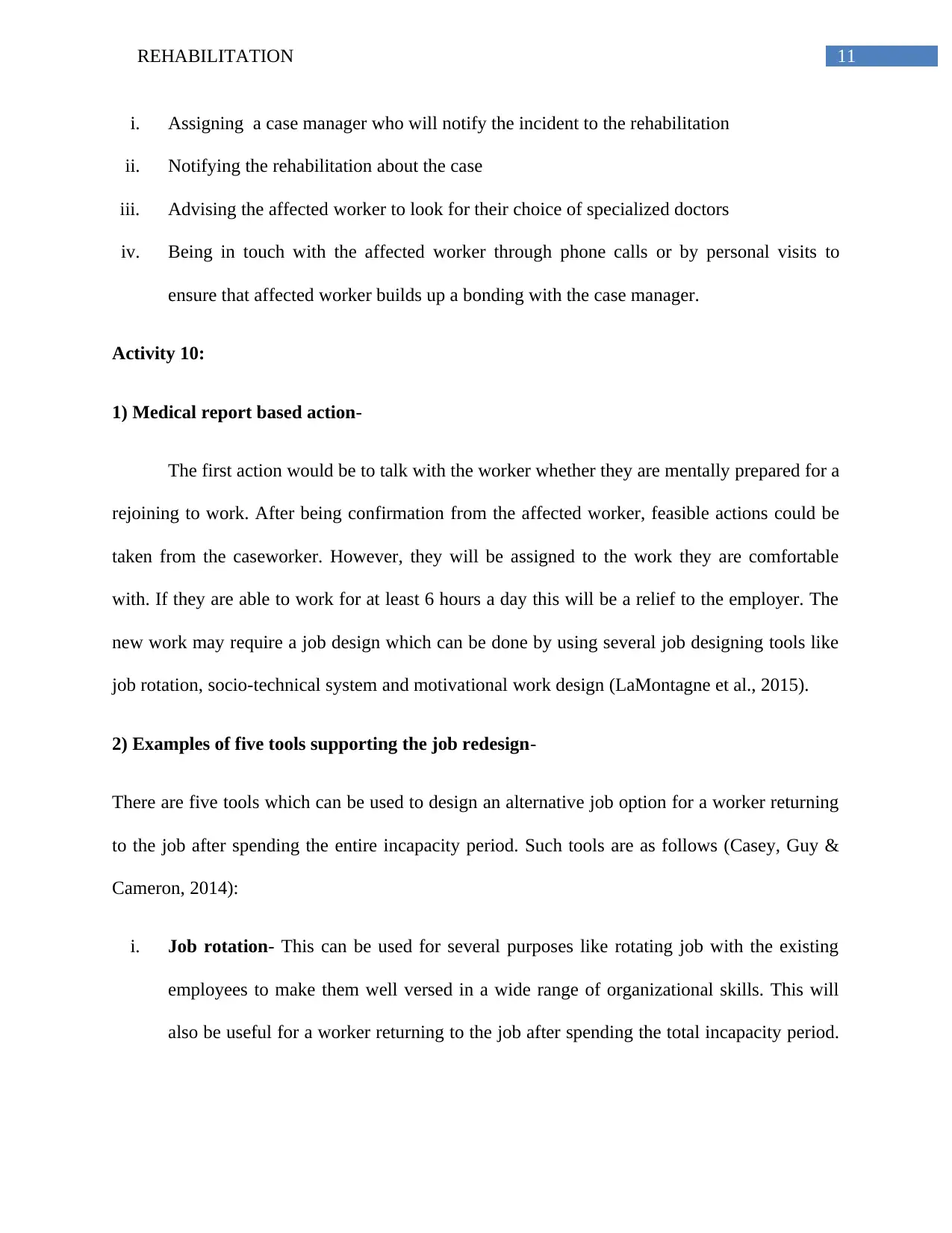
11REHABILITATION
i. Assigning a case manager who will notify the incident to the rehabilitation
ii. Notifying the rehabilitation about the case
iii. Advising the affected worker to look for their choice of specialized doctors
iv. Being in touch with the affected worker through phone calls or by personal visits to
ensure that affected worker builds up a bonding with the case manager.
Activity 10:
1) Medical report based action-
The first action would be to talk with the worker whether they are mentally prepared for a
rejoining to work. After being confirmation from the affected worker, feasible actions could be
taken from the caseworker. However, they will be assigned to the work they are comfortable
with. If they are able to work for at least 6 hours a day this will be a relief to the employer. The
new work may require a job design which can be done by using several job designing tools like
job rotation, socio-technical system and motivational work design (LaMontagne et al., 2015).
2) Examples of five tools supporting the job redesign-
There are five tools which can be used to design an alternative job option for a worker returning
to the job after spending the entire incapacity period. Such tools are as follows (Casey, Guy &
Cameron, 2014):
i. Job rotation- This can be used for several purposes like rotating job with the existing
employees to make them well versed in a wide range of organizational skills. This will
also be useful for a worker returning to the job after spending the total incapacity period.
i. Assigning a case manager who will notify the incident to the rehabilitation
ii. Notifying the rehabilitation about the case
iii. Advising the affected worker to look for their choice of specialized doctors
iv. Being in touch with the affected worker through phone calls or by personal visits to
ensure that affected worker builds up a bonding with the case manager.
Activity 10:
1) Medical report based action-
The first action would be to talk with the worker whether they are mentally prepared for a
rejoining to work. After being confirmation from the affected worker, feasible actions could be
taken from the caseworker. However, they will be assigned to the work they are comfortable
with. If they are able to work for at least 6 hours a day this will be a relief to the employer. The
new work may require a job design which can be done by using several job designing tools like
job rotation, socio-technical system and motivational work design (LaMontagne et al., 2015).
2) Examples of five tools supporting the job redesign-
There are five tools which can be used to design an alternative job option for a worker returning
to the job after spending the entire incapacity period. Such tools are as follows (Casey, Guy &
Cameron, 2014):
i. Job rotation- This can be used for several purposes like rotating job with the existing
employees to make them well versed in a wide range of organizational skills. This will
also be useful for a worker returning to the job after spending the total incapacity period.
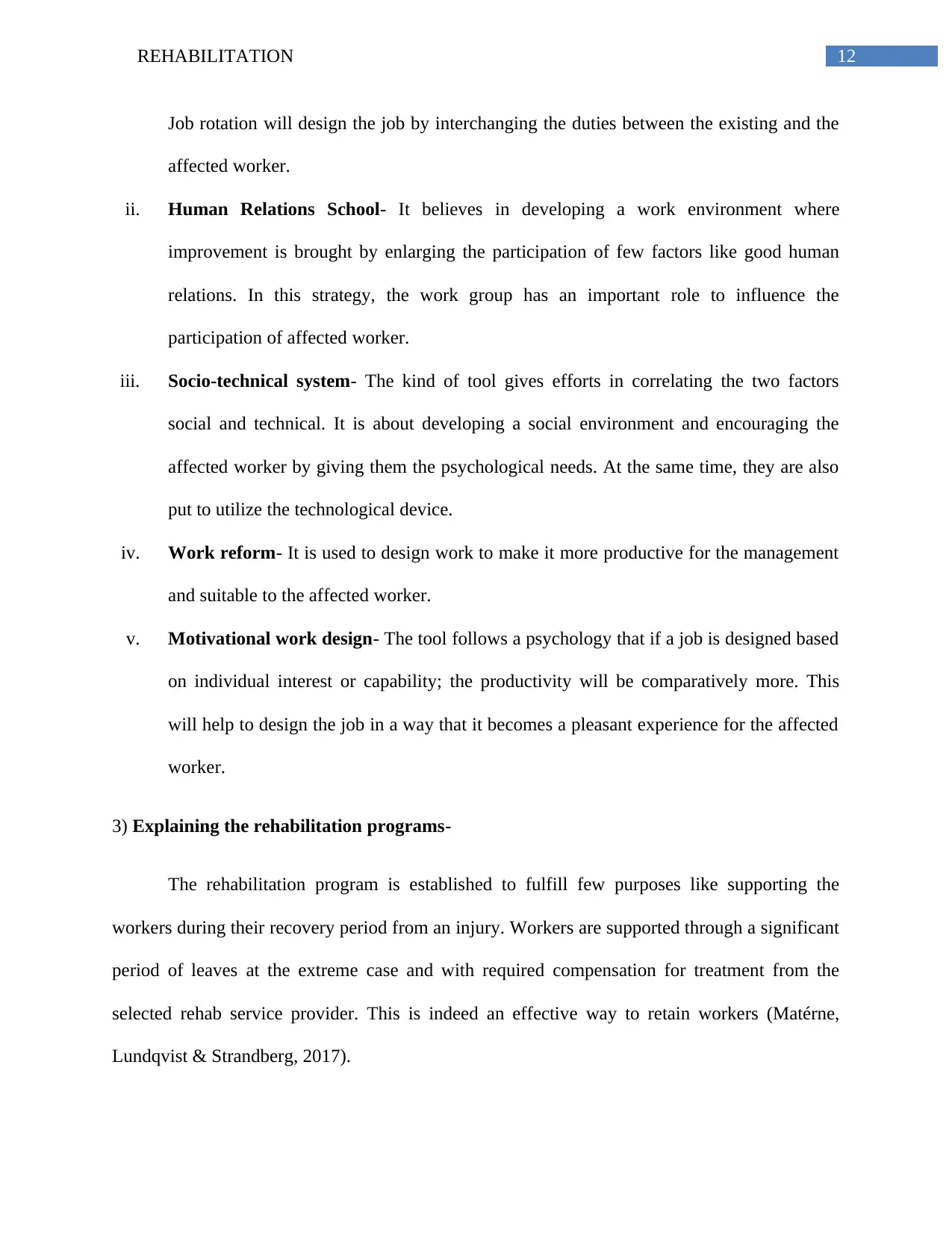
12REHABILITATION
Job rotation will design the job by interchanging the duties between the existing and the
affected worker.
ii. Human Relations School- It believes in developing a work environment where
improvement is brought by enlarging the participation of few factors like good human
relations. In this strategy, the work group has an important role to influence the
participation of affected worker.
iii. Socio-technical system- The kind of tool gives efforts in correlating the two factors
social and technical. It is about developing a social environment and encouraging the
affected worker by giving them the psychological needs. At the same time, they are also
put to utilize the technological device.
iv. Work reform- It is used to design work to make it more productive for the management
and suitable to the affected worker.
v. Motivational work design- The tool follows a psychology that if a job is designed based
on individual interest or capability; the productivity will be comparatively more. This
will help to design the job in a way that it becomes a pleasant experience for the affected
worker.
3) Explaining the rehabilitation programs-
The rehabilitation program is established to fulfill few purposes like supporting the
workers during their recovery period from an injury. Workers are supported through a significant
period of leaves at the extreme case and with required compensation for treatment from the
selected rehab service provider. This is indeed an effective way to retain workers (Matérne,
Lundqvist & Strandberg, 2017).
Job rotation will design the job by interchanging the duties between the existing and the
affected worker.
ii. Human Relations School- It believes in developing a work environment where
improvement is brought by enlarging the participation of few factors like good human
relations. In this strategy, the work group has an important role to influence the
participation of affected worker.
iii. Socio-technical system- The kind of tool gives efforts in correlating the two factors
social and technical. It is about developing a social environment and encouraging the
affected worker by giving them the psychological needs. At the same time, they are also
put to utilize the technological device.
iv. Work reform- It is used to design work to make it more productive for the management
and suitable to the affected worker.
v. Motivational work design- The tool follows a psychology that if a job is designed based
on individual interest or capability; the productivity will be comparatively more. This
will help to design the job in a way that it becomes a pleasant experience for the affected
worker.
3) Explaining the rehabilitation programs-
The rehabilitation program is established to fulfill few purposes like supporting the
workers during their recovery period from an injury. Workers are supported through a significant
period of leaves at the extreme case and with required compensation for treatment from the
selected rehab service provider. This is indeed an effective way to retain workers (Matérne,
Lundqvist & Strandberg, 2017).
Paraphrase This Document
Need a fresh take? Get an instant paraphrase of this document with our AI Paraphraser
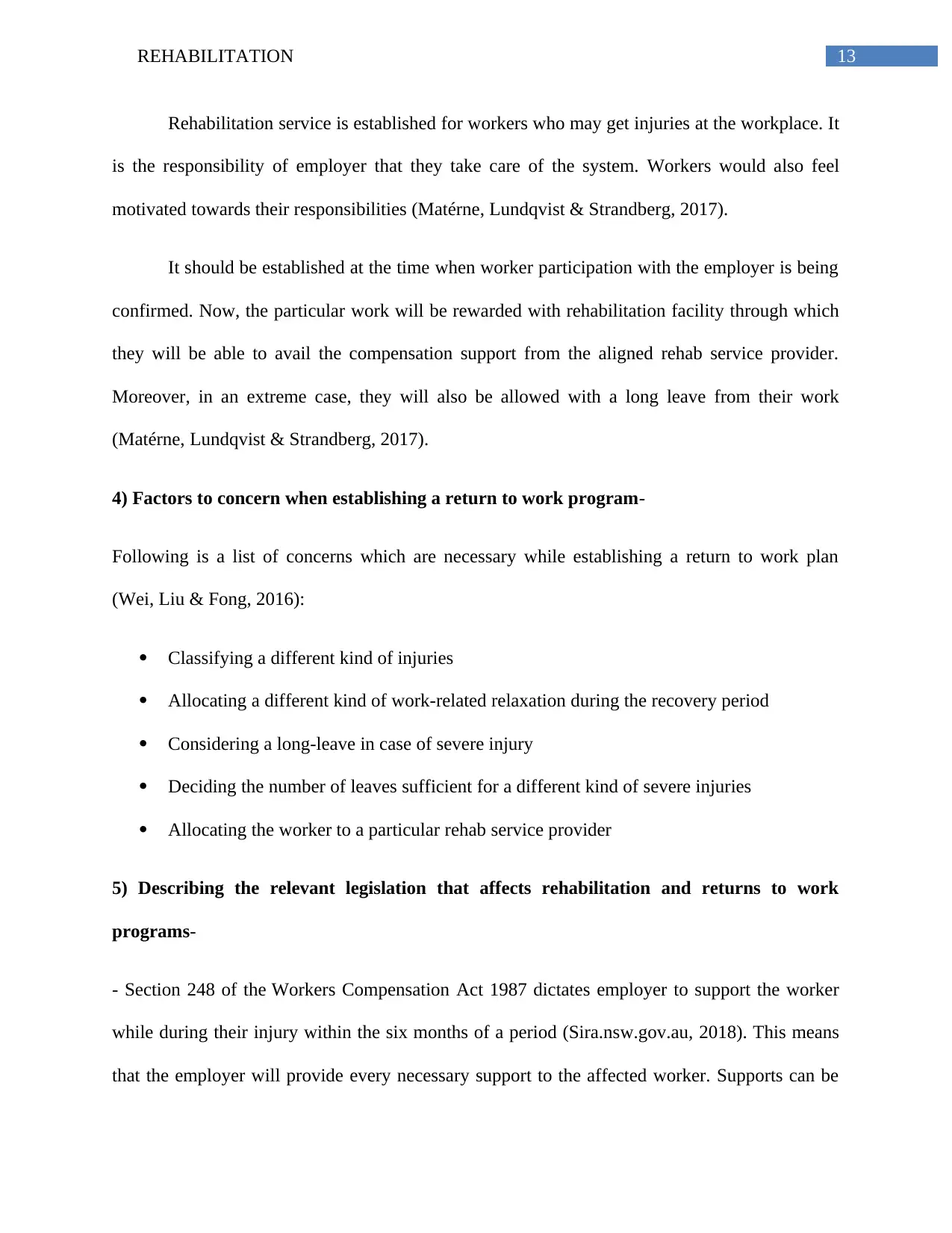
13REHABILITATION
Rehabilitation service is established for workers who may get injuries at the workplace. It
is the responsibility of employer that they take care of the system. Workers would also feel
motivated towards their responsibilities (Matérne, Lundqvist & Strandberg, 2017).
It should be established at the time when worker participation with the employer is being
confirmed. Now, the particular work will be rewarded with rehabilitation facility through which
they will be able to avail the compensation support from the aligned rehab service provider.
Moreover, in an extreme case, they will also be allowed with a long leave from their work
(Matérne, Lundqvist & Strandberg, 2017).
4) Factors to concern when establishing a return to work program-
Following is a list of concerns which are necessary while establishing a return to work plan
(Wei, Liu & Fong, 2016):
Classifying a different kind of injuries
Allocating a different kind of work-related relaxation during the recovery period
Considering a long-leave in case of severe injury
Deciding the number of leaves sufficient for a different kind of severe injuries
Allocating the worker to a particular rehab service provider
5) Describing the relevant legislation that affects rehabilitation and returns to work
programs-
- Section 248 of the Workers Compensation Act 1987 dictates employer to support the worker
while during their injury within the six months of a period (Sira.nsw.gov.au, 2018). This means
that the employer will provide every necessary support to the affected worker. Supports can be
Rehabilitation service is established for workers who may get injuries at the workplace. It
is the responsibility of employer that they take care of the system. Workers would also feel
motivated towards their responsibilities (Matérne, Lundqvist & Strandberg, 2017).
It should be established at the time when worker participation with the employer is being
confirmed. Now, the particular work will be rewarded with rehabilitation facility through which
they will be able to avail the compensation support from the aligned rehab service provider.
Moreover, in an extreme case, they will also be allowed with a long leave from their work
(Matérne, Lundqvist & Strandberg, 2017).
4) Factors to concern when establishing a return to work program-
Following is a list of concerns which are necessary while establishing a return to work plan
(Wei, Liu & Fong, 2016):
Classifying a different kind of injuries
Allocating a different kind of work-related relaxation during the recovery period
Considering a long-leave in case of severe injury
Deciding the number of leaves sufficient for a different kind of severe injuries
Allocating the worker to a particular rehab service provider
5) Describing the relevant legislation that affects rehabilitation and returns to work
programs-
- Section 248 of the Workers Compensation Act 1987 dictates employer to support the worker
while during their injury within the six months of a period (Sira.nsw.gov.au, 2018). This means
that the employer will provide every necessary support to the affected worker. Supports can be
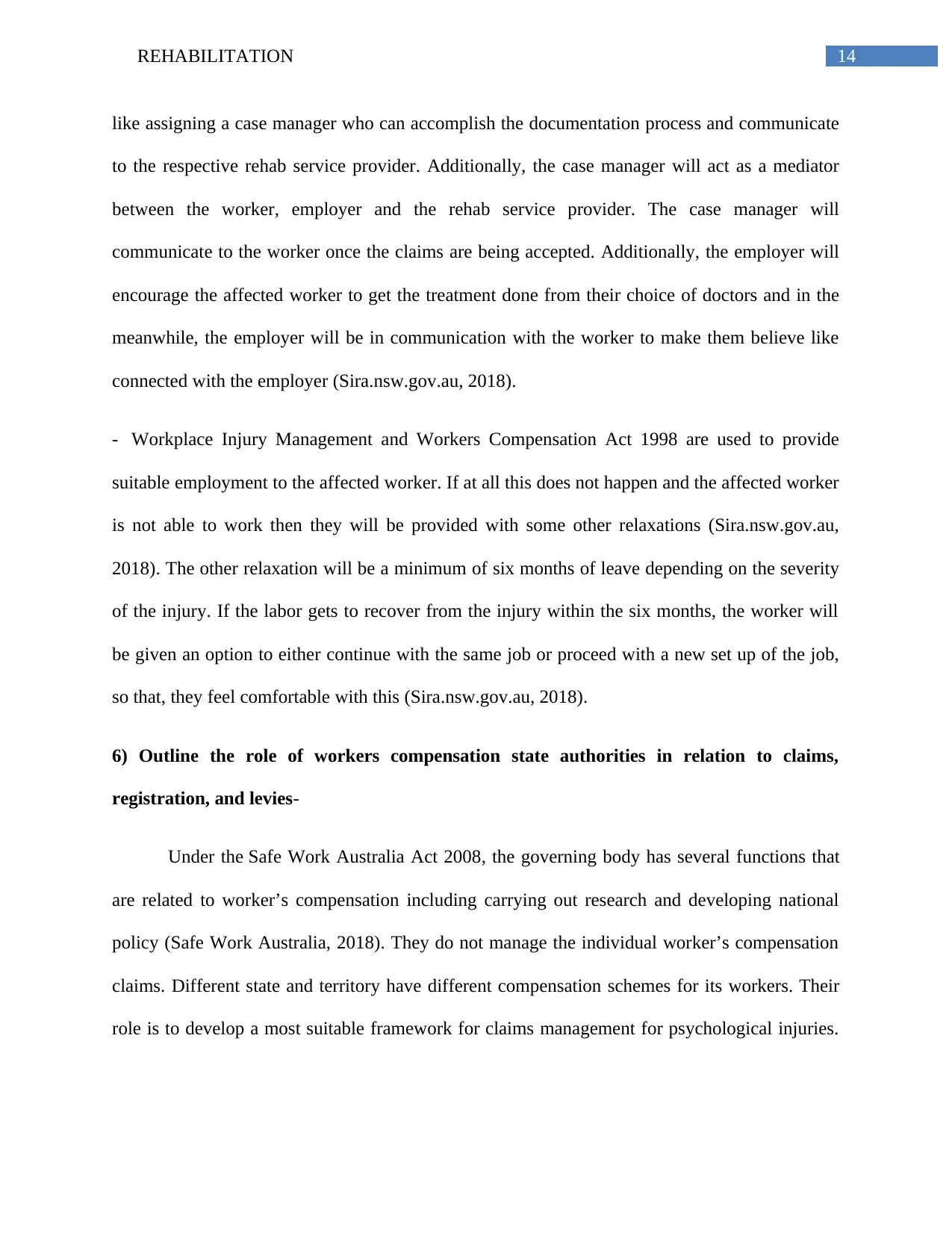
14REHABILITATION
like assigning a case manager who can accomplish the documentation process and communicate
to the respective rehab service provider. Additionally, the case manager will act as a mediator
between the worker, employer and the rehab service provider. The case manager will
communicate to the worker once the claims are being accepted. Additionally, the employer will
encourage the affected worker to get the treatment done from their choice of doctors and in the
meanwhile, the employer will be in communication with the worker to make them believe like
connected with the employer (Sira.nsw.gov.au, 2018).
- Workplace Injury Management and Workers Compensation Act 1998 are used to provide
suitable employment to the affected worker. If at all this does not happen and the affected worker
is not able to work then they will be provided with some other relaxations (Sira.nsw.gov.au,
2018). The other relaxation will be a minimum of six months of leave depending on the severity
of the injury. If the labor gets to recover from the injury within the six months, the worker will
be given an option to either continue with the same job or proceed with a new set up of the job,
so that, they feel comfortable with this (Sira.nsw.gov.au, 2018).
6) Outline the role of workers compensation state authorities in relation to claims,
registration, and levies-
Under the Safe Work Australia Act 2008, the governing body has several functions that
are related to worker’s compensation including carrying out research and developing national
policy (Safe Work Australia, 2018). They do not manage the individual worker’s compensation
claims. Different state and territory have different compensation schemes for its workers. Their
role is to develop a most suitable framework for claims management for psychological injuries.
like assigning a case manager who can accomplish the documentation process and communicate
to the respective rehab service provider. Additionally, the case manager will act as a mediator
between the worker, employer and the rehab service provider. The case manager will
communicate to the worker once the claims are being accepted. Additionally, the employer will
encourage the affected worker to get the treatment done from their choice of doctors and in the
meanwhile, the employer will be in communication with the worker to make them believe like
connected with the employer (Sira.nsw.gov.au, 2018).
- Workplace Injury Management and Workers Compensation Act 1998 are used to provide
suitable employment to the affected worker. If at all this does not happen and the affected worker
is not able to work then they will be provided with some other relaxations (Sira.nsw.gov.au,
2018). The other relaxation will be a minimum of six months of leave depending on the severity
of the injury. If the labor gets to recover from the injury within the six months, the worker will
be given an option to either continue with the same job or proceed with a new set up of the job,
so that, they feel comfortable with this (Sira.nsw.gov.au, 2018).
6) Outline the role of workers compensation state authorities in relation to claims,
registration, and levies-
Under the Safe Work Australia Act 2008, the governing body has several functions that
are related to worker’s compensation including carrying out research and developing national
policy (Safe Work Australia, 2018). They do not manage the individual worker’s compensation
claims. Different state and territory have different compensation schemes for its workers. Their
role is to develop a most suitable framework for claims management for psychological injuries.
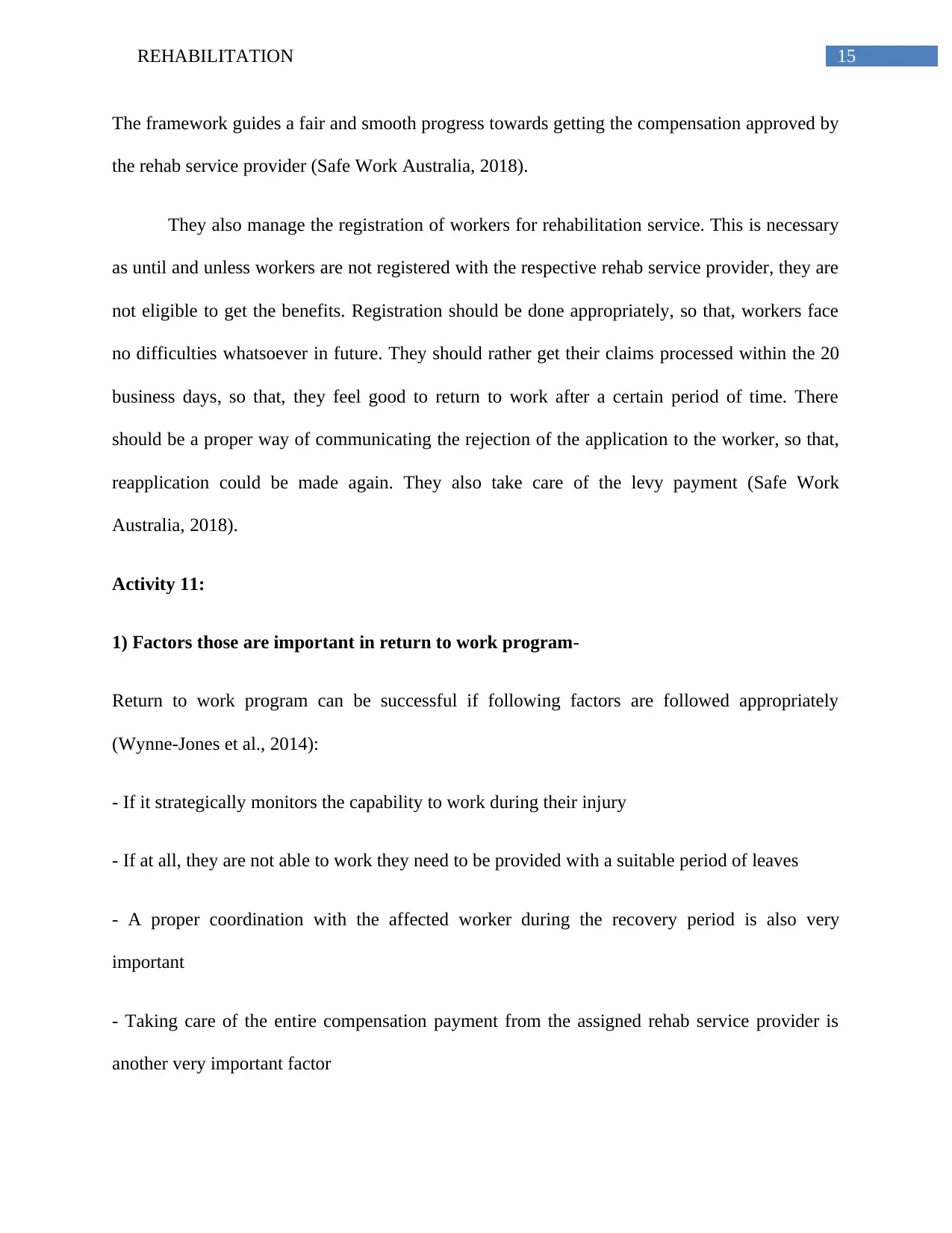
15REHABILITATION
The framework guides a fair and smooth progress towards getting the compensation approved by
the rehab service provider (Safe Work Australia, 2018).
They also manage the registration of workers for rehabilitation service. This is necessary
as until and unless workers are not registered with the respective rehab service provider, they are
not eligible to get the benefits. Registration should be done appropriately, so that, workers face
no difficulties whatsoever in future. They should rather get their claims processed within the 20
business days, so that, they feel good to return to work after a certain period of time. There
should be a proper way of communicating the rejection of the application to the worker, so that,
reapplication could be made again. They also take care of the levy payment (Safe Work
Australia, 2018).
Activity 11:
1) Factors those are important in return to work program-
Return to work program can be successful if following factors are followed appropriately
(Wynne-Jones et al., 2014):
- If it strategically monitors the capability to work during their injury
- If at all, they are not able to work they need to be provided with a suitable period of leaves
- A proper coordination with the affected worker during the recovery period is also very
important
- Taking care of the entire compensation payment from the assigned rehab service provider is
another very important factor
The framework guides a fair and smooth progress towards getting the compensation approved by
the rehab service provider (Safe Work Australia, 2018).
They also manage the registration of workers for rehabilitation service. This is necessary
as until and unless workers are not registered with the respective rehab service provider, they are
not eligible to get the benefits. Registration should be done appropriately, so that, workers face
no difficulties whatsoever in future. They should rather get their claims processed within the 20
business days, so that, they feel good to return to work after a certain period of time. There
should be a proper way of communicating the rejection of the application to the worker, so that,
reapplication could be made again. They also take care of the levy payment (Safe Work
Australia, 2018).
Activity 11:
1) Factors those are important in return to work program-
Return to work program can be successful if following factors are followed appropriately
(Wynne-Jones et al., 2014):
- If it strategically monitors the capability to work during their injury
- If at all, they are not able to work they need to be provided with a suitable period of leaves
- A proper coordination with the affected worker during the recovery period is also very
important
- Taking care of the entire compensation payment from the assigned rehab service provider is
another very important factor
Secure Best Marks with AI Grader
Need help grading? Try our AI Grader for instant feedback on your assignments.
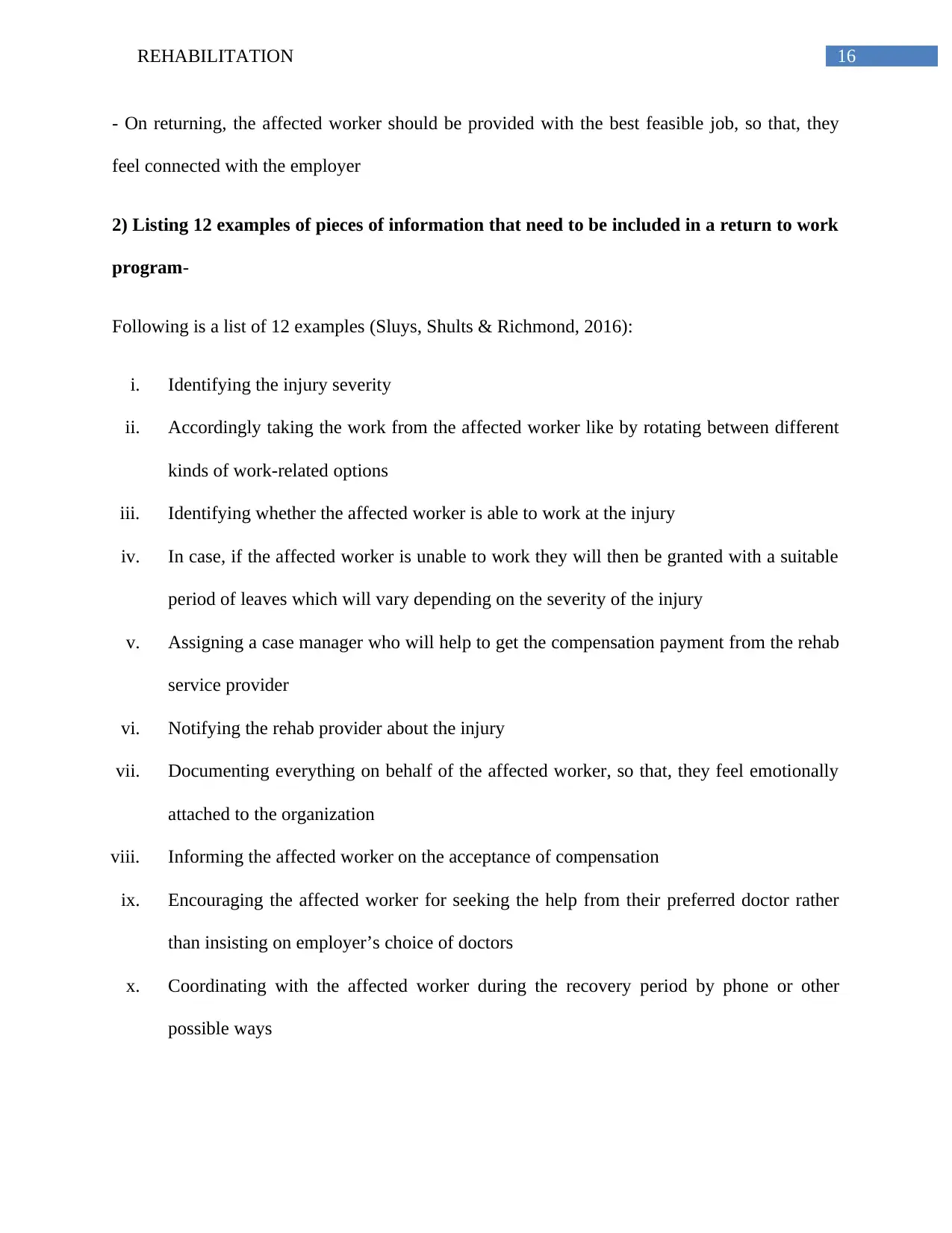
16REHABILITATION
- On returning, the affected worker should be provided with the best feasible job, so that, they
feel connected with the employer
2) Listing 12 examples of pieces of information that need to be included in a return to work
program-
Following is a list of 12 examples (Sluys, Shults & Richmond, 2016):
i. Identifying the injury severity
ii. Accordingly taking the work from the affected worker like by rotating between different
kinds of work-related options
iii. Identifying whether the affected worker is able to work at the injury
iv. In case, if the affected worker is unable to work they will then be granted with a suitable
period of leaves which will vary depending on the severity of the injury
v. Assigning a case manager who will help to get the compensation payment from the rehab
service provider
vi. Notifying the rehab provider about the injury
vii. Documenting everything on behalf of the affected worker, so that, they feel emotionally
attached to the organization
viii. Informing the affected worker on the acceptance of compensation
ix. Encouraging the affected worker for seeking the help from their preferred doctor rather
than insisting on employer’s choice of doctors
x. Coordinating with the affected worker during the recovery period by phone or other
possible ways
- On returning, the affected worker should be provided with the best feasible job, so that, they
feel connected with the employer
2) Listing 12 examples of pieces of information that need to be included in a return to work
program-
Following is a list of 12 examples (Sluys, Shults & Richmond, 2016):
i. Identifying the injury severity
ii. Accordingly taking the work from the affected worker like by rotating between different
kinds of work-related options
iii. Identifying whether the affected worker is able to work at the injury
iv. In case, if the affected worker is unable to work they will then be granted with a suitable
period of leaves which will vary depending on the severity of the injury
v. Assigning a case manager who will help to get the compensation payment from the rehab
service provider
vi. Notifying the rehab provider about the injury
vii. Documenting everything on behalf of the affected worker, so that, they feel emotionally
attached to the organization
viii. Informing the affected worker on the acceptance of compensation
ix. Encouraging the affected worker for seeking the help from their preferred doctor rather
than insisting on employer’s choice of doctors
x. Coordinating with the affected worker during the recovery period by phone or other
possible ways
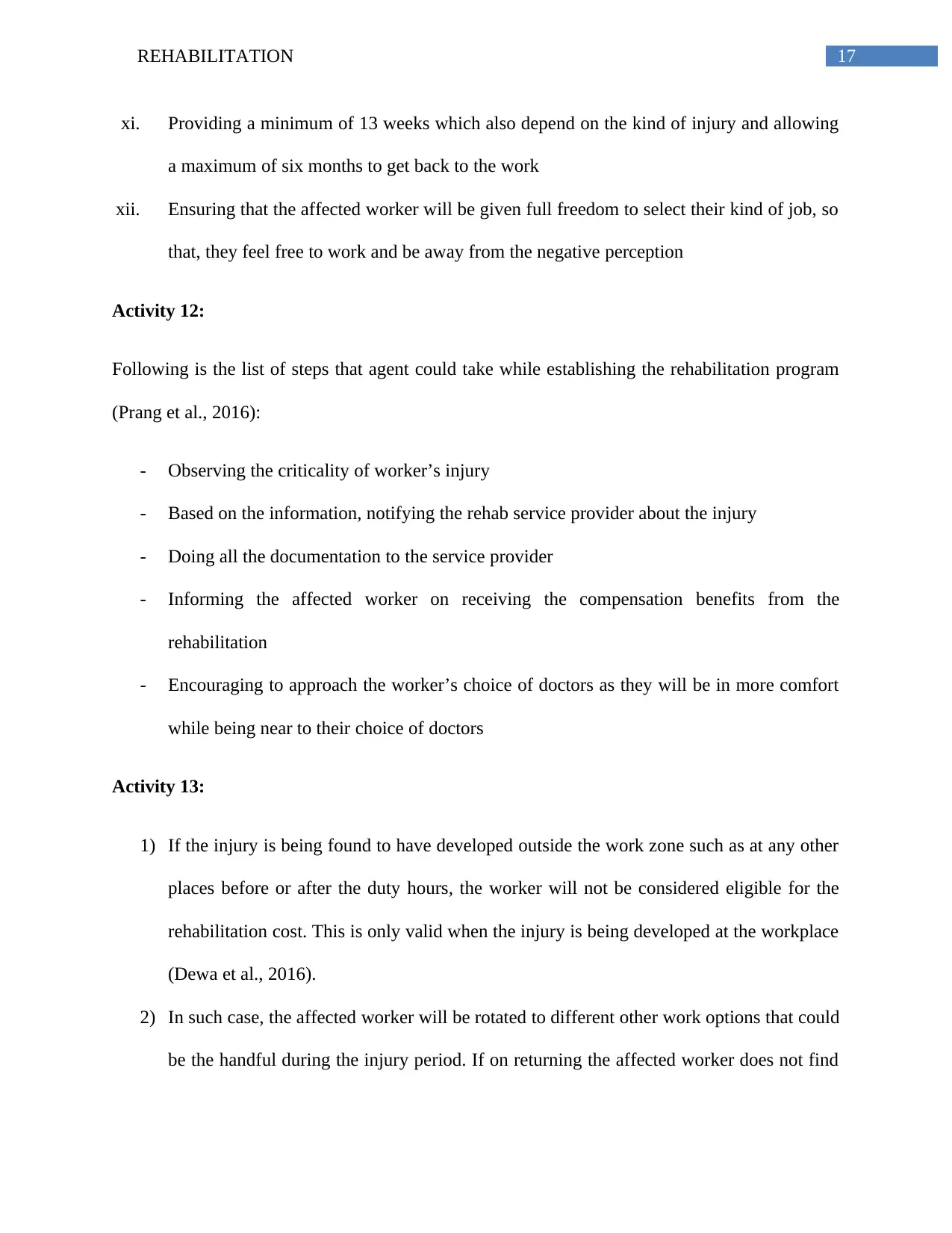
17REHABILITATION
xi. Providing a minimum of 13 weeks which also depend on the kind of injury and allowing
a maximum of six months to get back to the work
xii. Ensuring that the affected worker will be given full freedom to select their kind of job, so
that, they feel free to work and be away from the negative perception
Activity 12:
Following is the list of steps that agent could take while establishing the rehabilitation program
(Prang et al., 2016):
- Observing the criticality of worker’s injury
- Based on the information, notifying the rehab service provider about the injury
- Doing all the documentation to the service provider
- Informing the affected worker on receiving the compensation benefits from the
rehabilitation
- Encouraging to approach the worker’s choice of doctors as they will be in more comfort
while being near to their choice of doctors
Activity 13:
1) If the injury is being found to have developed outside the work zone such as at any other
places before or after the duty hours, the worker will not be considered eligible for the
rehabilitation cost. This is only valid when the injury is being developed at the workplace
(Dewa et al., 2016).
2) In such case, the affected worker will be rotated to different other work options that could
be the handful during the injury period. If on returning the affected worker does not find
xi. Providing a minimum of 13 weeks which also depend on the kind of injury and allowing
a maximum of six months to get back to the work
xii. Ensuring that the affected worker will be given full freedom to select their kind of job, so
that, they feel free to work and be away from the negative perception
Activity 12:
Following is the list of steps that agent could take while establishing the rehabilitation program
(Prang et al., 2016):
- Observing the criticality of worker’s injury
- Based on the information, notifying the rehab service provider about the injury
- Doing all the documentation to the service provider
- Informing the affected worker on receiving the compensation benefits from the
rehabilitation
- Encouraging to approach the worker’s choice of doctors as they will be in more comfort
while being near to their choice of doctors
Activity 13:
1) If the injury is being found to have developed outside the work zone such as at any other
places before or after the duty hours, the worker will not be considered eligible for the
rehabilitation cost. This is only valid when the injury is being developed at the workplace
(Dewa et al., 2016).
2) In such case, the affected worker will be rotated to different other work options that could
be the handful during the injury period. If on returning the affected worker does not find
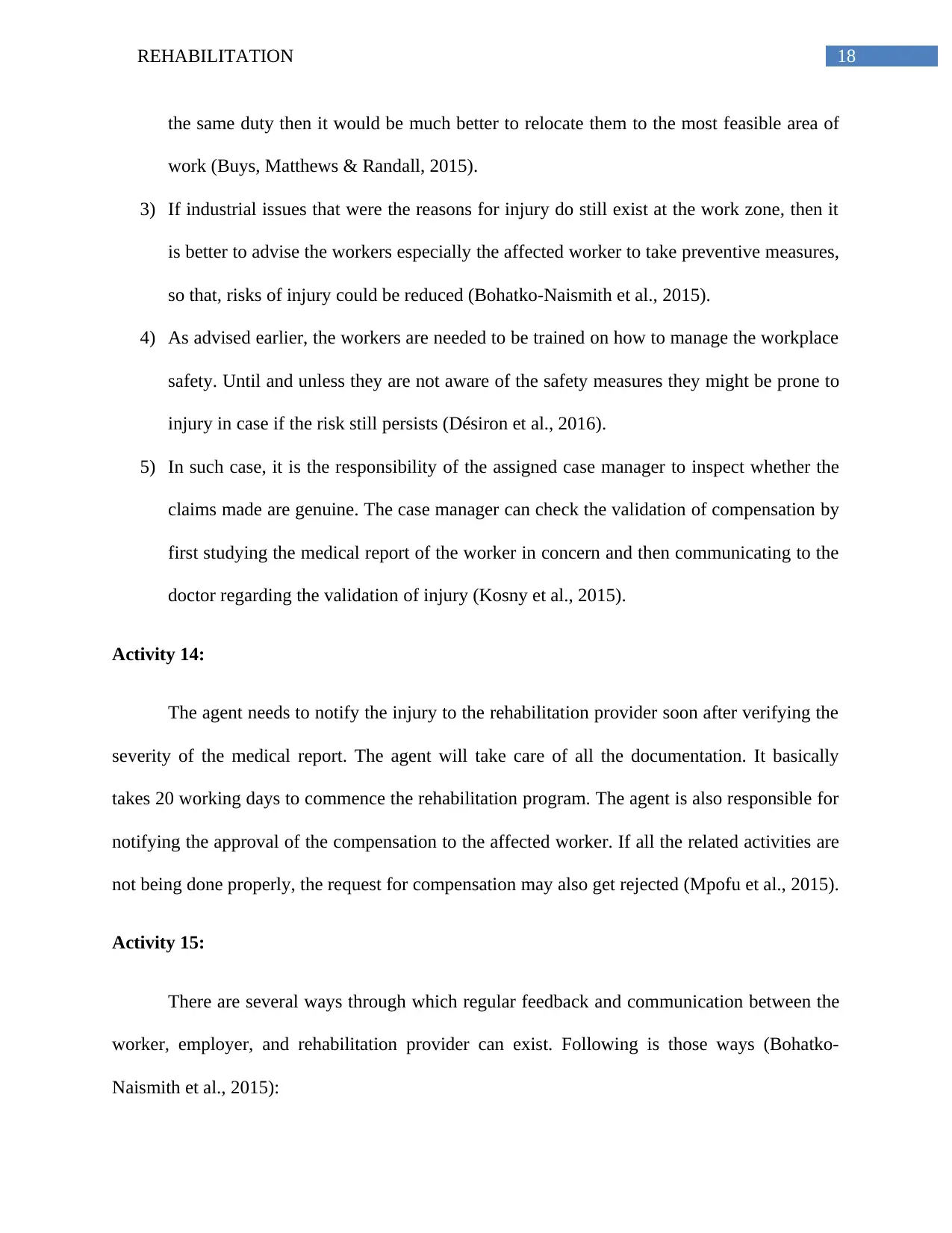
18REHABILITATION
the same duty then it would be much better to relocate them to the most feasible area of
work (Buys, Matthews & Randall, 2015).
3) If industrial issues that were the reasons for injury do still exist at the work zone, then it
is better to advise the workers especially the affected worker to take preventive measures,
so that, risks of injury could be reduced (Bohatko-Naismith et al., 2015).
4) As advised earlier, the workers are needed to be trained on how to manage the workplace
safety. Until and unless they are not aware of the safety measures they might be prone to
injury in case if the risk still persists (Désiron et al., 2016).
5) In such case, it is the responsibility of the assigned case manager to inspect whether the
claims made are genuine. The case manager can check the validation of compensation by
first studying the medical report of the worker in concern and then communicating to the
doctor regarding the validation of injury (Kosny et al., 2015).
Activity 14:
The agent needs to notify the injury to the rehabilitation provider soon after verifying the
severity of the medical report. The agent will take care of all the documentation. It basically
takes 20 working days to commence the rehabilitation program. The agent is also responsible for
notifying the approval of the compensation to the affected worker. If all the related activities are
not being done properly, the request for compensation may also get rejected (Mpofu et al., 2015).
Activity 15:
There are several ways through which regular feedback and communication between the
worker, employer, and rehabilitation provider can exist. Following is those ways (Bohatko-
Naismith et al., 2015):
the same duty then it would be much better to relocate them to the most feasible area of
work (Buys, Matthews & Randall, 2015).
3) If industrial issues that were the reasons for injury do still exist at the work zone, then it
is better to advise the workers especially the affected worker to take preventive measures,
so that, risks of injury could be reduced (Bohatko-Naismith et al., 2015).
4) As advised earlier, the workers are needed to be trained on how to manage the workplace
safety. Until and unless they are not aware of the safety measures they might be prone to
injury in case if the risk still persists (Désiron et al., 2016).
5) In such case, it is the responsibility of the assigned case manager to inspect whether the
claims made are genuine. The case manager can check the validation of compensation by
first studying the medical report of the worker in concern and then communicating to the
doctor regarding the validation of injury (Kosny et al., 2015).
Activity 14:
The agent needs to notify the injury to the rehabilitation provider soon after verifying the
severity of the medical report. The agent will take care of all the documentation. It basically
takes 20 working days to commence the rehabilitation program. The agent is also responsible for
notifying the approval of the compensation to the affected worker. If all the related activities are
not being done properly, the request for compensation may also get rejected (Mpofu et al., 2015).
Activity 15:
There are several ways through which regular feedback and communication between the
worker, employer, and rehabilitation provider can exist. Following is those ways (Bohatko-
Naismith et al., 2015):
Paraphrase This Document
Need a fresh take? Get an instant paraphrase of this document with our AI Paraphraser
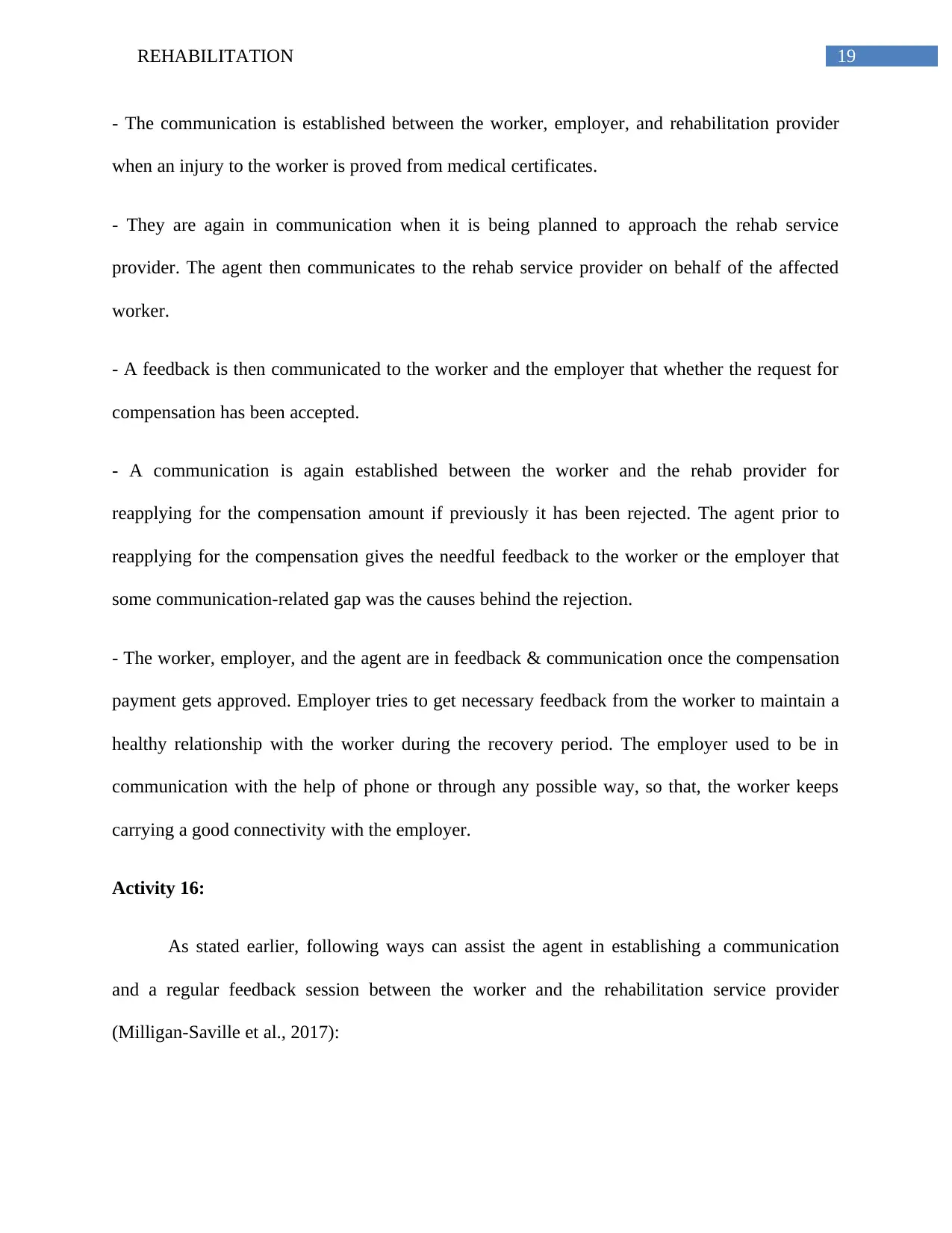
19REHABILITATION
- The communication is established between the worker, employer, and rehabilitation provider
when an injury to the worker is proved from medical certificates.
- They are again in communication when it is being planned to approach the rehab service
provider. The agent then communicates to the rehab service provider on behalf of the affected
worker.
- A feedback is then communicated to the worker and the employer that whether the request for
compensation has been accepted.
- A communication is again established between the worker and the rehab provider for
reapplying for the compensation amount if previously it has been rejected. The agent prior to
reapplying for the compensation gives the needful feedback to the worker or the employer that
some communication-related gap was the causes behind the rejection.
- The worker, employer, and the agent are in feedback & communication once the compensation
payment gets approved. Employer tries to get necessary feedback from the worker to maintain a
healthy relationship with the worker during the recovery period. The employer used to be in
communication with the help of phone or through any possible way, so that, the worker keeps
carrying a good connectivity with the employer.
Activity 16:
As stated earlier, following ways can assist the agent in establishing a communication
and a regular feedback session between the worker and the rehabilitation service provider
(Milligan-Saville et al., 2017):
- The communication is established between the worker, employer, and rehabilitation provider
when an injury to the worker is proved from medical certificates.
- They are again in communication when it is being planned to approach the rehab service
provider. The agent then communicates to the rehab service provider on behalf of the affected
worker.
- A feedback is then communicated to the worker and the employer that whether the request for
compensation has been accepted.
- A communication is again established between the worker and the rehab provider for
reapplying for the compensation amount if previously it has been rejected. The agent prior to
reapplying for the compensation gives the needful feedback to the worker or the employer that
some communication-related gap was the causes behind the rejection.
- The worker, employer, and the agent are in feedback & communication once the compensation
payment gets approved. Employer tries to get necessary feedback from the worker to maintain a
healthy relationship with the worker during the recovery period. The employer used to be in
communication with the help of phone or through any possible way, so that, the worker keeps
carrying a good connectivity with the employer.
Activity 16:
As stated earlier, following ways can assist the agent in establishing a communication
and a regular feedback session between the worker and the rehabilitation service provider
(Milligan-Saville et al., 2017):
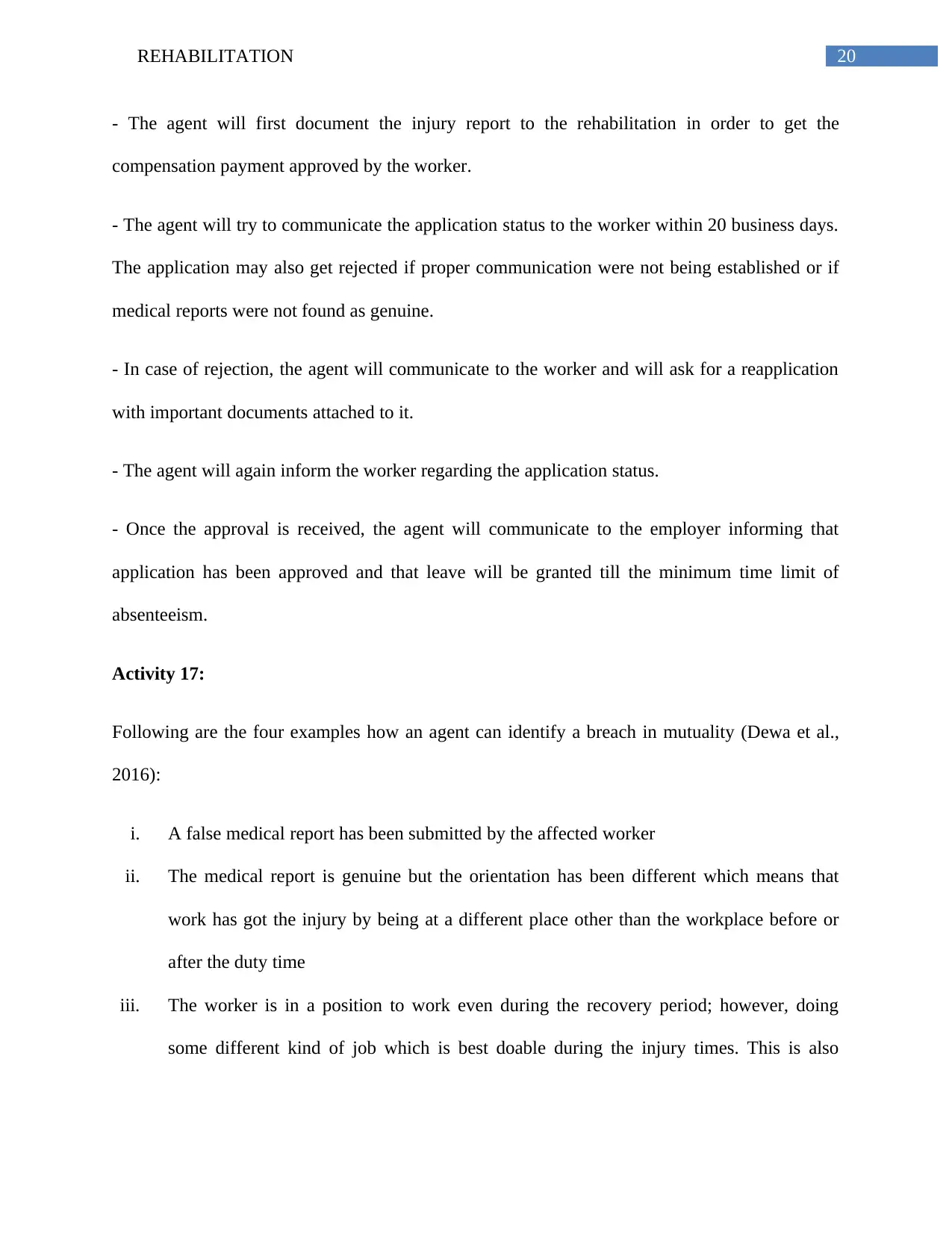
20REHABILITATION
- The agent will first document the injury report to the rehabilitation in order to get the
compensation payment approved by the worker.
- The agent will try to communicate the application status to the worker within 20 business days.
The application may also get rejected if proper communication were not being established or if
medical reports were not found as genuine.
- In case of rejection, the agent will communicate to the worker and will ask for a reapplication
with important documents attached to it.
- The agent will again inform the worker regarding the application status.
- Once the approval is received, the agent will communicate to the employer informing that
application has been approved and that leave will be granted till the minimum time limit of
absenteeism.
Activity 17:
Following are the four examples how an agent can identify a breach in mutuality (Dewa et al.,
2016):
i. A false medical report has been submitted by the affected worker
ii. The medical report is genuine but the orientation has been different which means that
work has got the injury by being at a different place other than the workplace before or
after the duty time
iii. The worker is in a position to work even during the recovery period; however, doing
some different kind of job which is best doable during the injury times. This is also
- The agent will first document the injury report to the rehabilitation in order to get the
compensation payment approved by the worker.
- The agent will try to communicate the application status to the worker within 20 business days.
The application may also get rejected if proper communication were not being established or if
medical reports were not found as genuine.
- In case of rejection, the agent will communicate to the worker and will ask for a reapplication
with important documents attached to it.
- The agent will again inform the worker regarding the application status.
- Once the approval is received, the agent will communicate to the employer informing that
application has been approved and that leave will be granted till the minimum time limit of
absenteeism.
Activity 17:
Following are the four examples how an agent can identify a breach in mutuality (Dewa et al.,
2016):
i. A false medical report has been submitted by the affected worker
ii. The medical report is genuine but the orientation has been different which means that
work has got the injury by being at a different place other than the workplace before or
after the duty time
iii. The worker is in a position to work even during the recovery period; however, doing
some different kind of job which is best doable during the injury times. This is also
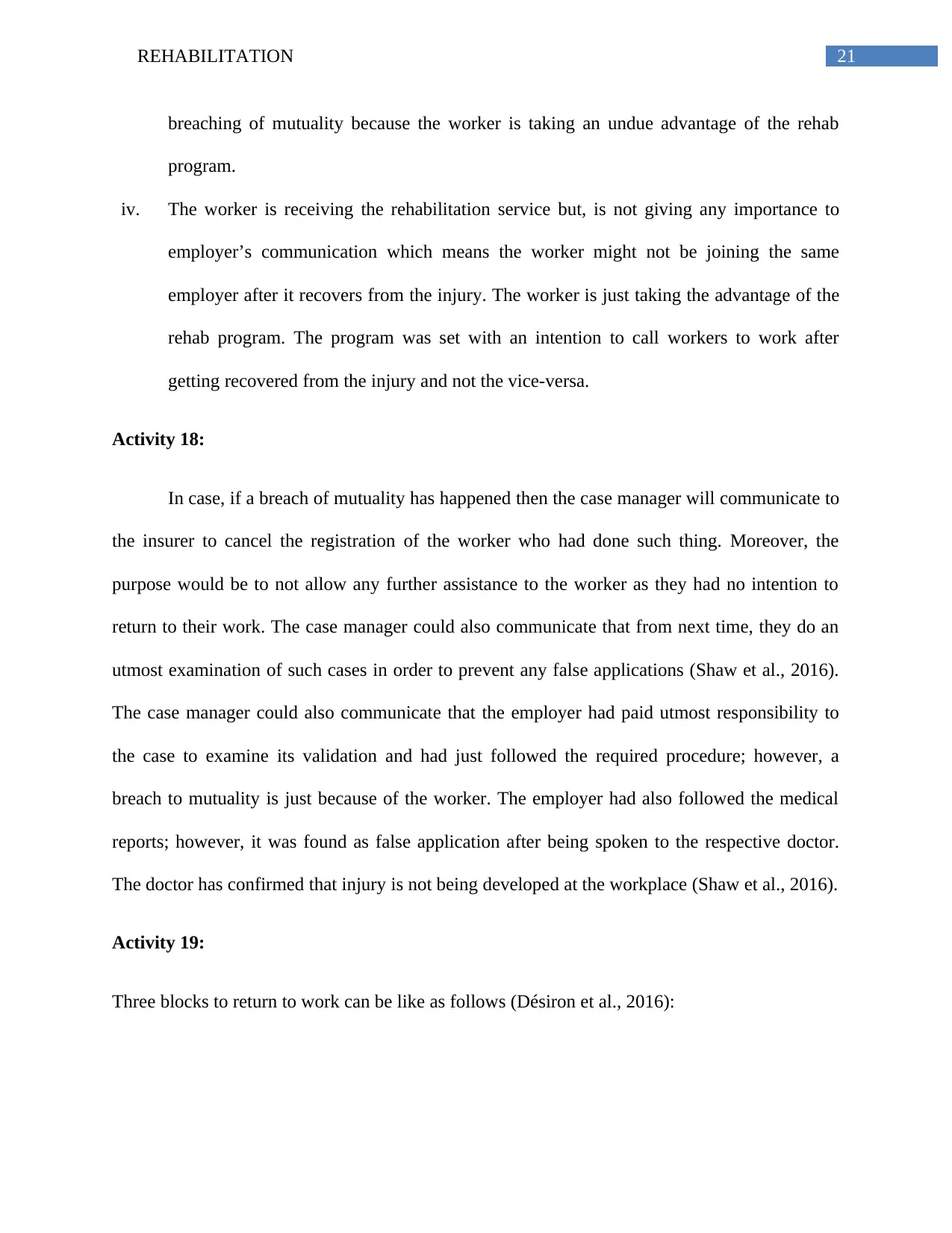
21REHABILITATION
breaching of mutuality because the worker is taking an undue advantage of the rehab
program.
iv. The worker is receiving the rehabilitation service but, is not giving any importance to
employer’s communication which means the worker might not be joining the same
employer after it recovers from the injury. The worker is just taking the advantage of the
rehab program. The program was set with an intention to call workers to work after
getting recovered from the injury and not the vice-versa.
Activity 18:
In case, if a breach of mutuality has happened then the case manager will communicate to
the insurer to cancel the registration of the worker who had done such thing. Moreover, the
purpose would be to not allow any further assistance to the worker as they had no intention to
return to their work. The case manager could also communicate that from next time, they do an
utmost examination of such cases in order to prevent any false applications (Shaw et al., 2016).
The case manager could also communicate that the employer had paid utmost responsibility to
the case to examine its validation and had just followed the required procedure; however, a
breach to mutuality is just because of the worker. The employer had also followed the medical
reports; however, it was found as false application after being spoken to the respective doctor.
The doctor has confirmed that injury is not being developed at the workplace (Shaw et al., 2016).
Activity 19:
Three blocks to return to work can be like as follows (Désiron et al., 2016):
breaching of mutuality because the worker is taking an undue advantage of the rehab
program.
iv. The worker is receiving the rehabilitation service but, is not giving any importance to
employer’s communication which means the worker might not be joining the same
employer after it recovers from the injury. The worker is just taking the advantage of the
rehab program. The program was set with an intention to call workers to work after
getting recovered from the injury and not the vice-versa.
Activity 18:
In case, if a breach of mutuality has happened then the case manager will communicate to
the insurer to cancel the registration of the worker who had done such thing. Moreover, the
purpose would be to not allow any further assistance to the worker as they had no intention to
return to their work. The case manager could also communicate that from next time, they do an
utmost examination of such cases in order to prevent any false applications (Shaw et al., 2016).
The case manager could also communicate that the employer had paid utmost responsibility to
the case to examine its validation and had just followed the required procedure; however, a
breach to mutuality is just because of the worker. The employer had also followed the medical
reports; however, it was found as false application after being spoken to the respective doctor.
The doctor has confirmed that injury is not being developed at the workplace (Shaw et al., 2016).
Activity 19:
Three blocks to return to work can be like as follows (Désiron et al., 2016):
Secure Best Marks with AI Grader
Need help grading? Try our AI Grader for instant feedback on your assignments.
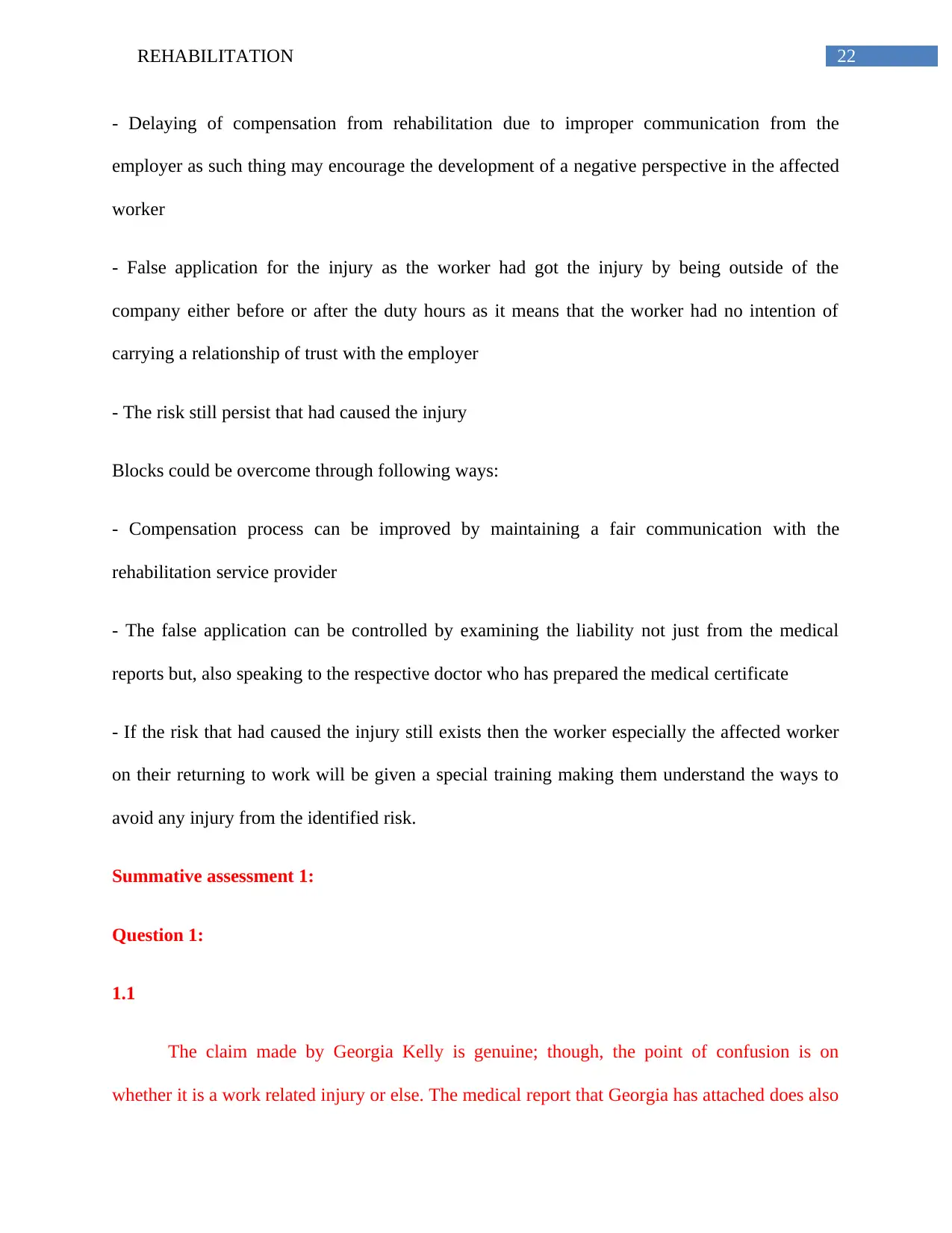
22REHABILITATION
- Delaying of compensation from rehabilitation due to improper communication from the
employer as such thing may encourage the development of a negative perspective in the affected
worker
- False application for the injury as the worker had got the injury by being outside of the
company either before or after the duty hours as it means that the worker had no intention of
carrying a relationship of trust with the employer
- The risk still persist that had caused the injury
Blocks could be overcome through following ways:
- Compensation process can be improved by maintaining a fair communication with the
rehabilitation service provider
- The false application can be controlled by examining the liability not just from the medical
reports but, also speaking to the respective doctor who has prepared the medical certificate
- If the risk that had caused the injury still exists then the worker especially the affected worker
on their returning to work will be given a special training making them understand the ways to
avoid any injury from the identified risk.
Summative assessment 1:
Question 1:
1.1
The claim made by Georgia Kelly is genuine; though, the point of confusion is on
whether it is a work related injury or else. The medical report that Georgia has attached does also
- Delaying of compensation from rehabilitation due to improper communication from the
employer as such thing may encourage the development of a negative perspective in the affected
worker
- False application for the injury as the worker had got the injury by being outside of the
company either before or after the duty hours as it means that the worker had no intention of
carrying a relationship of trust with the employer
- The risk still persist that had caused the injury
Blocks could be overcome through following ways:
- Compensation process can be improved by maintaining a fair communication with the
rehabilitation service provider
- The false application can be controlled by examining the liability not just from the medical
reports but, also speaking to the respective doctor who has prepared the medical certificate
- If the risk that had caused the injury still exists then the worker especially the affected worker
on their returning to work will be given a special training making them understand the ways to
avoid any injury from the identified risk.
Summative assessment 1:
Question 1:
1.1
The claim made by Georgia Kelly is genuine; though, the point of confusion is on
whether it is a work related injury or else. The medical report that Georgia has attached does also
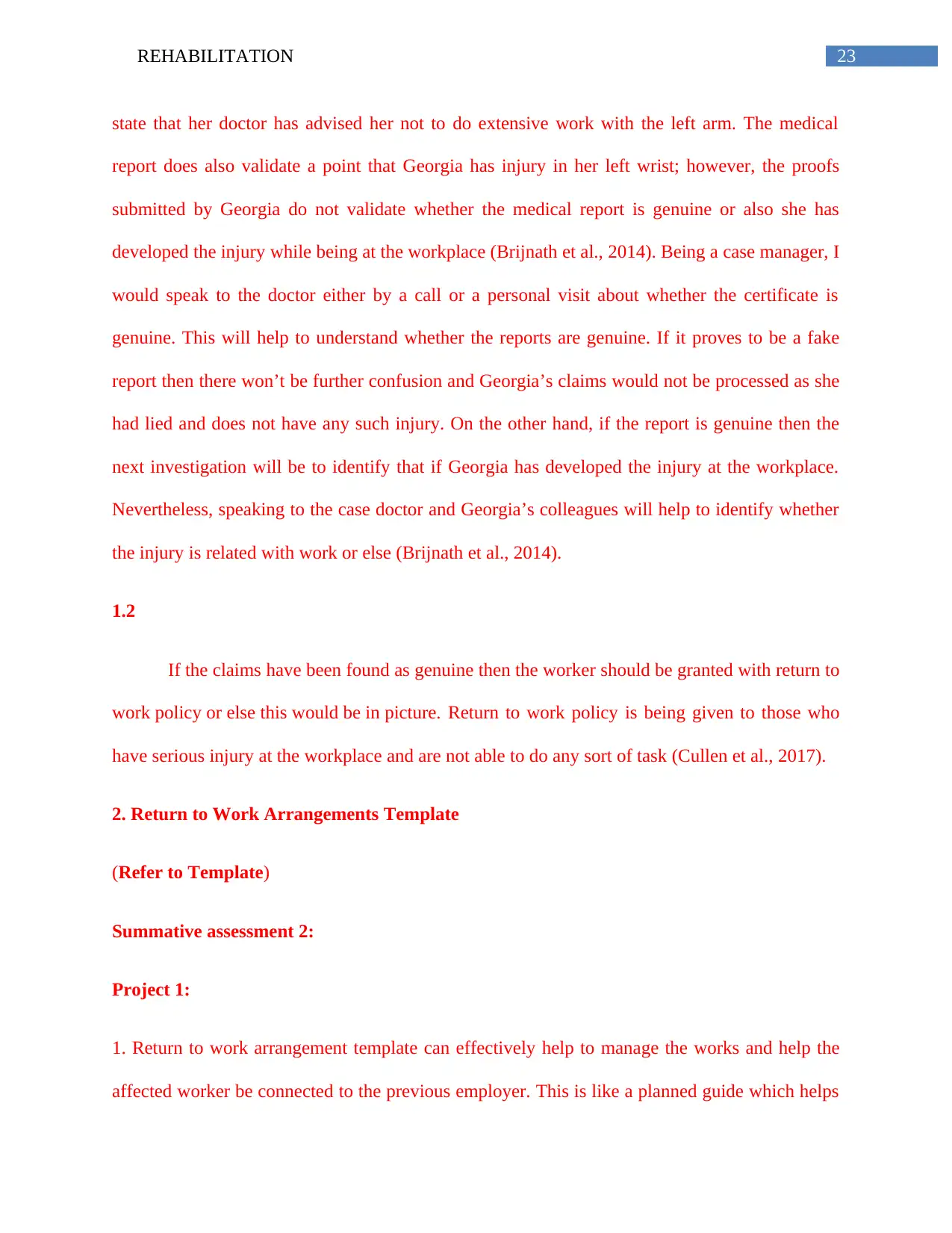
23REHABILITATION
state that her doctor has advised her not to do extensive work with the left arm. The medical
report does also validate a point that Georgia has injury in her left wrist; however, the proofs
submitted by Georgia do not validate whether the medical report is genuine or also she has
developed the injury while being at the workplace (Brijnath et al., 2014). Being a case manager, I
would speak to the doctor either by a call or a personal visit about whether the certificate is
genuine. This will help to understand whether the reports are genuine. If it proves to be a fake
report then there won’t be further confusion and Georgia’s claims would not be processed as she
had lied and does not have any such injury. On the other hand, if the report is genuine then the
next investigation will be to identify that if Georgia has developed the injury at the workplace.
Nevertheless, speaking to the case doctor and Georgia’s colleagues will help to identify whether
the injury is related with work or else (Brijnath et al., 2014).
1.2
If the claims have been found as genuine then the worker should be granted with return to
work policy or else this would be in picture. Return to work policy is being given to those who
have serious injury at the workplace and are not able to do any sort of task (Cullen et al., 2017).
2. Return to Work Arrangements Template
(Refer to Template)
Summative assessment 2:
Project 1:
1. Return to work arrangement template can effectively help to manage the works and help the
affected worker be connected to the previous employer. This is like a planned guide which helps
state that her doctor has advised her not to do extensive work with the left arm. The medical
report does also validate a point that Georgia has injury in her left wrist; however, the proofs
submitted by Georgia do not validate whether the medical report is genuine or also she has
developed the injury while being at the workplace (Brijnath et al., 2014). Being a case manager, I
would speak to the doctor either by a call or a personal visit about whether the certificate is
genuine. This will help to understand whether the reports are genuine. If it proves to be a fake
report then there won’t be further confusion and Georgia’s claims would not be processed as she
had lied and does not have any such injury. On the other hand, if the report is genuine then the
next investigation will be to identify that if Georgia has developed the injury at the workplace.
Nevertheless, speaking to the case doctor and Georgia’s colleagues will help to identify whether
the injury is related with work or else (Brijnath et al., 2014).
1.2
If the claims have been found as genuine then the worker should be granted with return to
work policy or else this would be in picture. Return to work policy is being given to those who
have serious injury at the workplace and are not able to do any sort of task (Cullen et al., 2017).
2. Return to Work Arrangements Template
(Refer to Template)
Summative assessment 2:
Project 1:
1. Return to work arrangement template can effectively help to manage the works and help the
affected worker be connected to the previous employer. This is like a planned guide which helps
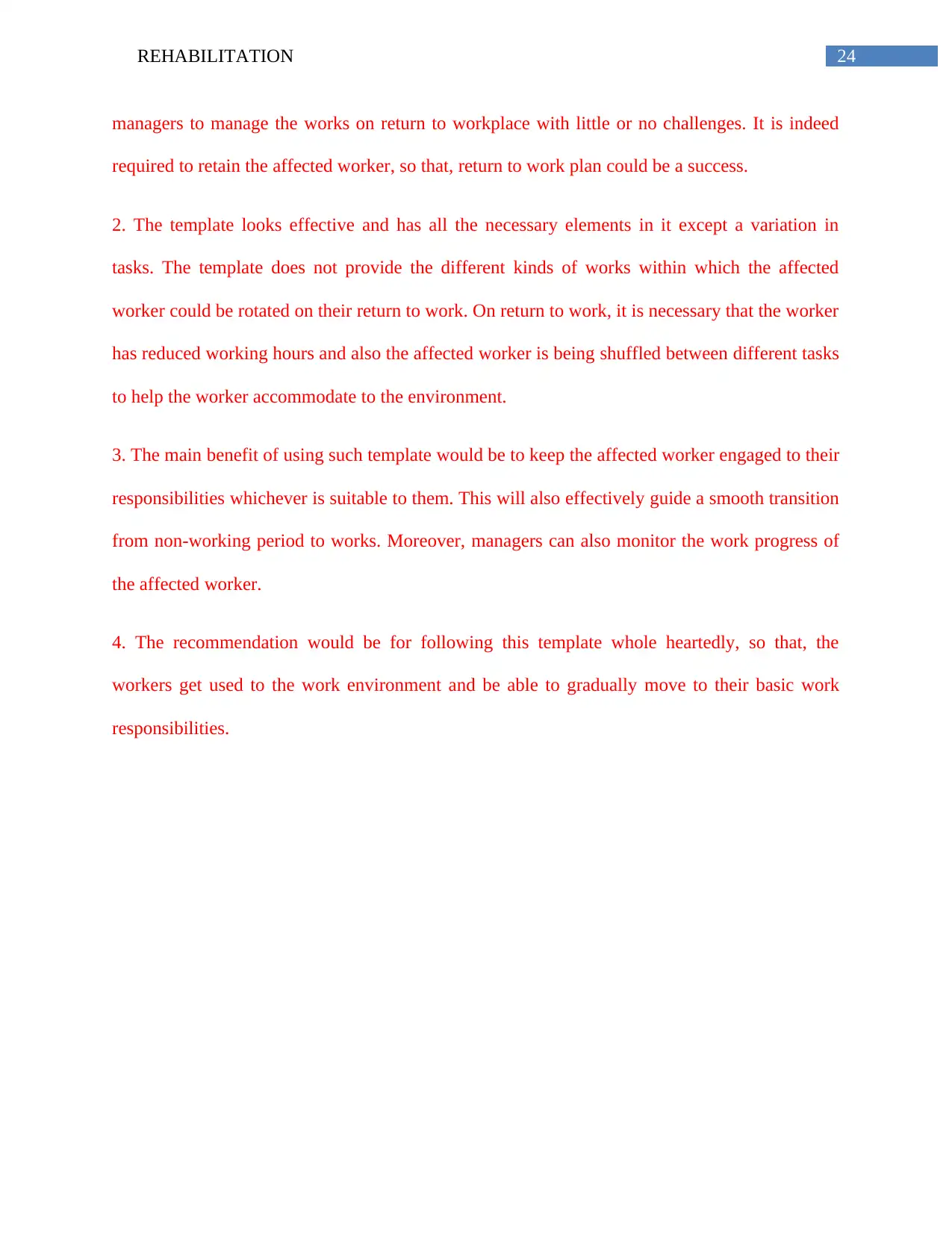
24REHABILITATION
managers to manage the works on return to workplace with little or no challenges. It is indeed
required to retain the affected worker, so that, return to work plan could be a success.
2. The template looks effective and has all the necessary elements in it except a variation in
tasks. The template does not provide the different kinds of works within which the affected
worker could be rotated on their return to work. On return to work, it is necessary that the worker
has reduced working hours and also the affected worker is being shuffled between different tasks
to help the worker accommodate to the environment.
3. The main benefit of using such template would be to keep the affected worker engaged to their
responsibilities whichever is suitable to them. This will also effectively guide a smooth transition
from non-working period to works. Moreover, managers can also monitor the work progress of
the affected worker.
4. The recommendation would be for following this template whole heartedly, so that, the
workers get used to the work environment and be able to gradually move to their basic work
responsibilities.
managers to manage the works on return to workplace with little or no challenges. It is indeed
required to retain the affected worker, so that, return to work plan could be a success.
2. The template looks effective and has all the necessary elements in it except a variation in
tasks. The template does not provide the different kinds of works within which the affected
worker could be rotated on their return to work. On return to work, it is necessary that the worker
has reduced working hours and also the affected worker is being shuffled between different tasks
to help the worker accommodate to the environment.
3. The main benefit of using such template would be to keep the affected worker engaged to their
responsibilities whichever is suitable to them. This will also effectively guide a smooth transition
from non-working period to works. Moreover, managers can also monitor the work progress of
the affected worker.
4. The recommendation would be for following this template whole heartedly, so that, the
workers get used to the work environment and be able to gradually move to their basic work
responsibilities.
Paraphrase This Document
Need a fresh take? Get an instant paraphrase of this document with our AI Paraphraser
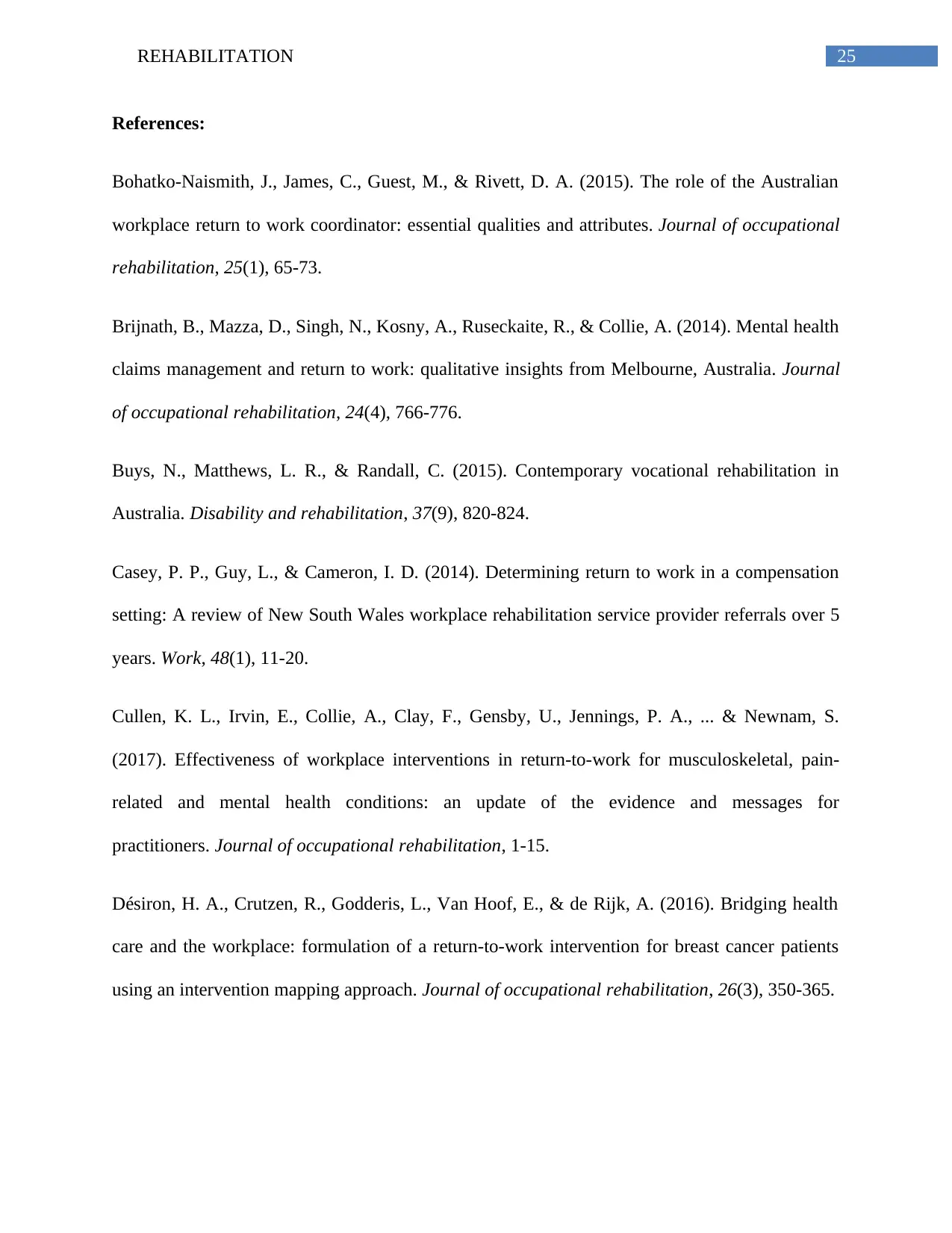
25REHABILITATION
References:
Bohatko-Naismith, J., James, C., Guest, M., & Rivett, D. A. (2015). The role of the Australian
workplace return to work coordinator: essential qualities and attributes. Journal of occupational
rehabilitation, 25(1), 65-73.
Brijnath, B., Mazza, D., Singh, N., Kosny, A., Ruseckaite, R., & Collie, A. (2014). Mental health
claims management and return to work: qualitative insights from Melbourne, Australia. Journal
of occupational rehabilitation, 24(4), 766-776.
Buys, N., Matthews, L. R., & Randall, C. (2015). Contemporary vocational rehabilitation in
Australia. Disability and rehabilitation, 37(9), 820-824.
Casey, P. P., Guy, L., & Cameron, I. D. (2014). Determining return to work in a compensation
setting: A review of New South Wales workplace rehabilitation service provider referrals over 5
years. Work, 48(1), 11-20.
Cullen, K. L., Irvin, E., Collie, A., Clay, F., Gensby, U., Jennings, P. A., ... & Newnam, S.
(2017). Effectiveness of workplace interventions in return-to-work for musculoskeletal, pain-
related and mental health conditions: an update of the evidence and messages for
practitioners. Journal of occupational rehabilitation, 1-15.
Désiron, H. A., Crutzen, R., Godderis, L., Van Hoof, E., & de Rijk, A. (2016). Bridging health
care and the workplace: formulation of a return-to-work intervention for breast cancer patients
using an intervention mapping approach. Journal of occupational rehabilitation, 26(3), 350-365.
References:
Bohatko-Naismith, J., James, C., Guest, M., & Rivett, D. A. (2015). The role of the Australian
workplace return to work coordinator: essential qualities and attributes. Journal of occupational
rehabilitation, 25(1), 65-73.
Brijnath, B., Mazza, D., Singh, N., Kosny, A., Ruseckaite, R., & Collie, A. (2014). Mental health
claims management and return to work: qualitative insights from Melbourne, Australia. Journal
of occupational rehabilitation, 24(4), 766-776.
Buys, N., Matthews, L. R., & Randall, C. (2015). Contemporary vocational rehabilitation in
Australia. Disability and rehabilitation, 37(9), 820-824.
Casey, P. P., Guy, L., & Cameron, I. D. (2014). Determining return to work in a compensation
setting: A review of New South Wales workplace rehabilitation service provider referrals over 5
years. Work, 48(1), 11-20.
Cullen, K. L., Irvin, E., Collie, A., Clay, F., Gensby, U., Jennings, P. A., ... & Newnam, S.
(2017). Effectiveness of workplace interventions in return-to-work for musculoskeletal, pain-
related and mental health conditions: an update of the evidence and messages for
practitioners. Journal of occupational rehabilitation, 1-15.
Désiron, H. A., Crutzen, R., Godderis, L., Van Hoof, E., & de Rijk, A. (2016). Bridging health
care and the workplace: formulation of a return-to-work intervention for breast cancer patients
using an intervention mapping approach. Journal of occupational rehabilitation, 26(3), 350-365.
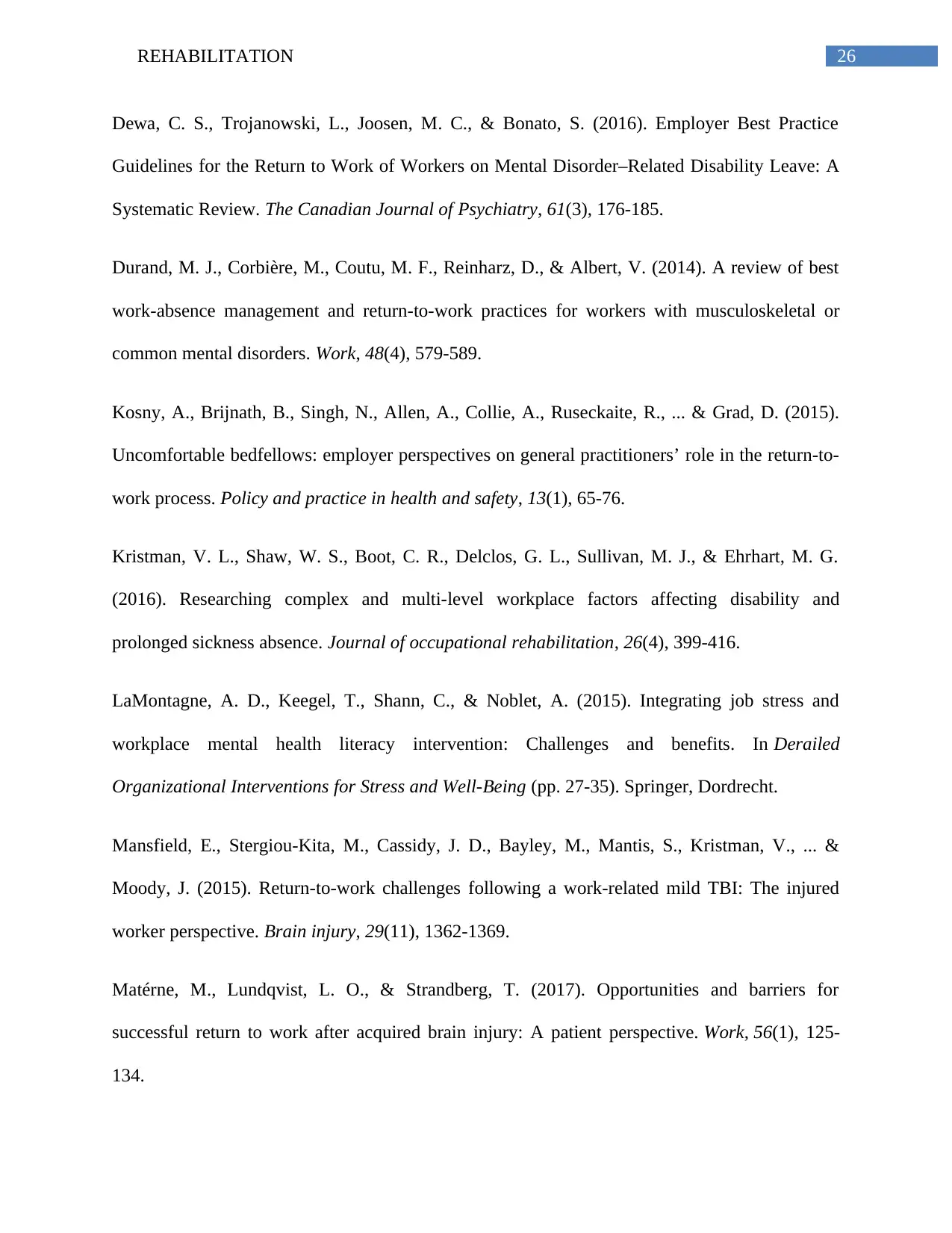
26REHABILITATION
Dewa, C. S., Trojanowski, L., Joosen, M. C., & Bonato, S. (2016). Employer Best Practice
Guidelines for the Return to Work of Workers on Mental Disorder–Related Disability Leave: A
Systematic Review. The Canadian Journal of Psychiatry, 61(3), 176-185.
Durand, M. J., Corbière, M., Coutu, M. F., Reinharz, D., & Albert, V. (2014). A review of best
work-absence management and return-to-work practices for workers with musculoskeletal or
common mental disorders. Work, 48(4), 579-589.
Kosny, A., Brijnath, B., Singh, N., Allen, A., Collie, A., Ruseckaite, R., ... & Grad, D. (2015).
Uncomfortable bedfellows: employer perspectives on general practitioners’ role in the return-to-
work process. Policy and practice in health and safety, 13(1), 65-76.
Kristman, V. L., Shaw, W. S., Boot, C. R., Delclos, G. L., Sullivan, M. J., & Ehrhart, M. G.
(2016). Researching complex and multi-level workplace factors affecting disability and
prolonged sickness absence. Journal of occupational rehabilitation, 26(4), 399-416.
LaMontagne, A. D., Keegel, T., Shann, C., & Noblet, A. (2015). Integrating job stress and
workplace mental health literacy intervention: Challenges and benefits. In Derailed
Organizational Interventions for Stress and Well-Being (pp. 27-35). Springer, Dordrecht.
Mansfield, E., Stergiou-Kita, M., Cassidy, J. D., Bayley, M., Mantis, S., Kristman, V., ... &
Moody, J. (2015). Return-to-work challenges following a work-related mild TBI: The injured
worker perspective. Brain injury, 29(11), 1362-1369.
Matérne, M., Lundqvist, L. O., & Strandberg, T. (2017). Opportunities and barriers for
successful return to work after acquired brain injury: A patient perspective. Work, 56(1), 125-
134.
Dewa, C. S., Trojanowski, L., Joosen, M. C., & Bonato, S. (2016). Employer Best Practice
Guidelines for the Return to Work of Workers on Mental Disorder–Related Disability Leave: A
Systematic Review. The Canadian Journal of Psychiatry, 61(3), 176-185.
Durand, M. J., Corbière, M., Coutu, M. F., Reinharz, D., & Albert, V. (2014). A review of best
work-absence management and return-to-work practices for workers with musculoskeletal or
common mental disorders. Work, 48(4), 579-589.
Kosny, A., Brijnath, B., Singh, N., Allen, A., Collie, A., Ruseckaite, R., ... & Grad, D. (2015).
Uncomfortable bedfellows: employer perspectives on general practitioners’ role in the return-to-
work process. Policy and practice in health and safety, 13(1), 65-76.
Kristman, V. L., Shaw, W. S., Boot, C. R., Delclos, G. L., Sullivan, M. J., & Ehrhart, M. G.
(2016). Researching complex and multi-level workplace factors affecting disability and
prolonged sickness absence. Journal of occupational rehabilitation, 26(4), 399-416.
LaMontagne, A. D., Keegel, T., Shann, C., & Noblet, A. (2015). Integrating job stress and
workplace mental health literacy intervention: Challenges and benefits. In Derailed
Organizational Interventions for Stress and Well-Being (pp. 27-35). Springer, Dordrecht.
Mansfield, E., Stergiou-Kita, M., Cassidy, J. D., Bayley, M., Mantis, S., Kristman, V., ... &
Moody, J. (2015). Return-to-work challenges following a work-related mild TBI: The injured
worker perspective. Brain injury, 29(11), 1362-1369.
Matérne, M., Lundqvist, L. O., & Strandberg, T. (2017). Opportunities and barriers for
successful return to work after acquired brain injury: A patient perspective. Work, 56(1), 125-
134.
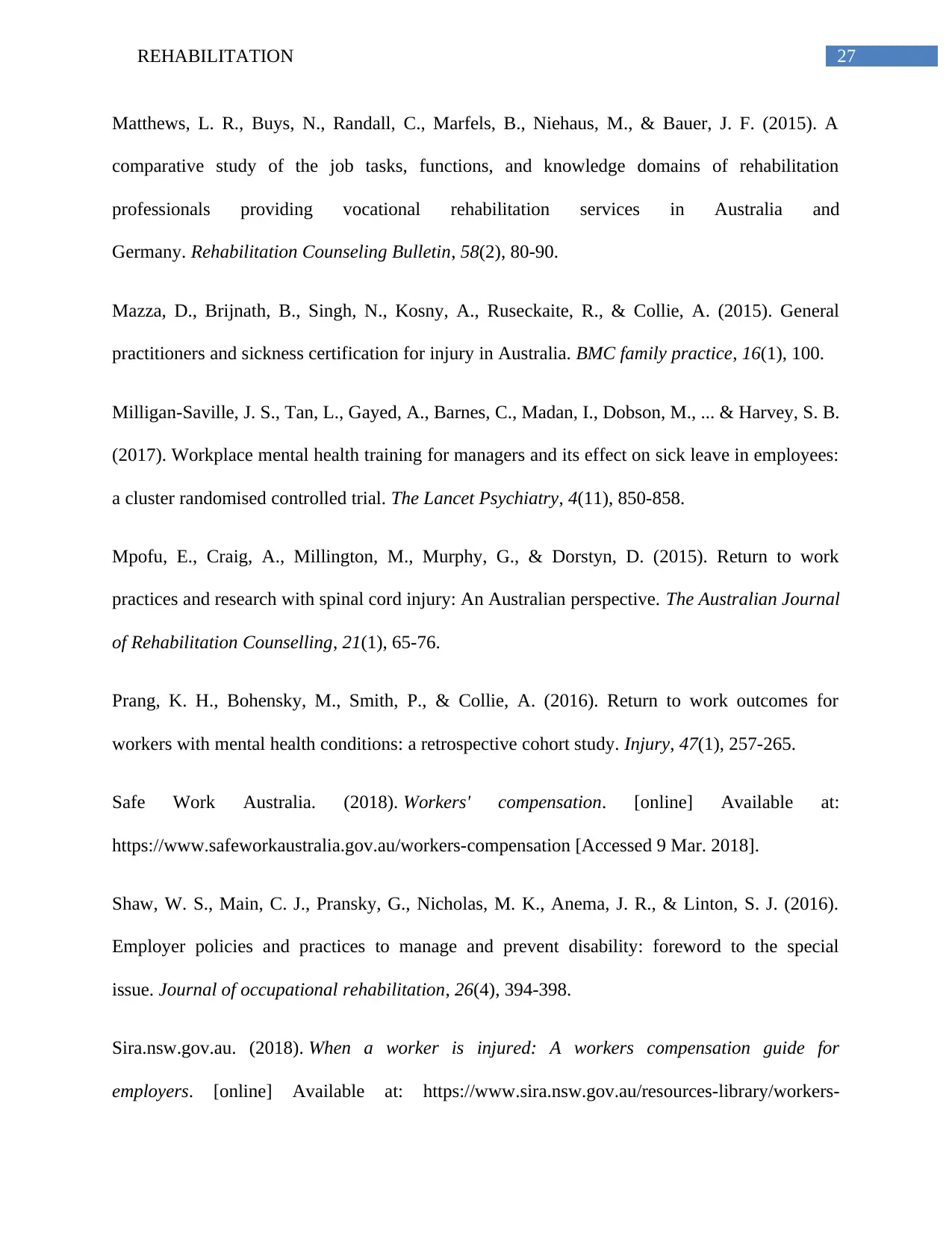
27REHABILITATION
Matthews, L. R., Buys, N., Randall, C., Marfels, B., Niehaus, M., & Bauer, J. F. (2015). A
comparative study of the job tasks, functions, and knowledge domains of rehabilitation
professionals providing vocational rehabilitation services in Australia and
Germany. Rehabilitation Counseling Bulletin, 58(2), 80-90.
Mazza, D., Brijnath, B., Singh, N., Kosny, A., Ruseckaite, R., & Collie, A. (2015). General
practitioners and sickness certification for injury in Australia. BMC family practice, 16(1), 100.
Milligan-Saville, J. S., Tan, L., Gayed, A., Barnes, C., Madan, I., Dobson, M., ... & Harvey, S. B.
(2017). Workplace mental health training for managers and its effect on sick leave in employees:
a cluster randomised controlled trial. The Lancet Psychiatry, 4(11), 850-858.
Mpofu, E., Craig, A., Millington, M., Murphy, G., & Dorstyn, D. (2015). Return to work
practices and research with spinal cord injury: An Australian perspective. The Australian Journal
of Rehabilitation Counselling, 21(1), 65-76.
Prang, K. H., Bohensky, M., Smith, P., & Collie, A. (2016). Return to work outcomes for
workers with mental health conditions: a retrospective cohort study. Injury, 47(1), 257-265.
Safe Work Australia. (2018). Workers' compensation. [online] Available at:
https://www.safeworkaustralia.gov.au/workers-compensation [Accessed 9 Mar. 2018].
Shaw, W. S., Main, C. J., Pransky, G., Nicholas, M. K., Anema, J. R., & Linton, S. J. (2016).
Employer policies and practices to manage and prevent disability: foreword to the special
issue. Journal of occupational rehabilitation, 26(4), 394-398.
Sira.nsw.gov.au. (2018). When a worker is injured: A workers compensation guide for
employers. [online] Available at: https://www.sira.nsw.gov.au/resources-library/workers-
Matthews, L. R., Buys, N., Randall, C., Marfels, B., Niehaus, M., & Bauer, J. F. (2015). A
comparative study of the job tasks, functions, and knowledge domains of rehabilitation
professionals providing vocational rehabilitation services in Australia and
Germany. Rehabilitation Counseling Bulletin, 58(2), 80-90.
Mazza, D., Brijnath, B., Singh, N., Kosny, A., Ruseckaite, R., & Collie, A. (2015). General
practitioners and sickness certification for injury in Australia. BMC family practice, 16(1), 100.
Milligan-Saville, J. S., Tan, L., Gayed, A., Barnes, C., Madan, I., Dobson, M., ... & Harvey, S. B.
(2017). Workplace mental health training for managers and its effect on sick leave in employees:
a cluster randomised controlled trial. The Lancet Psychiatry, 4(11), 850-858.
Mpofu, E., Craig, A., Millington, M., Murphy, G., & Dorstyn, D. (2015). Return to work
practices and research with spinal cord injury: An Australian perspective. The Australian Journal
of Rehabilitation Counselling, 21(1), 65-76.
Prang, K. H., Bohensky, M., Smith, P., & Collie, A. (2016). Return to work outcomes for
workers with mental health conditions: a retrospective cohort study. Injury, 47(1), 257-265.
Safe Work Australia. (2018). Workers' compensation. [online] Available at:
https://www.safeworkaustralia.gov.au/workers-compensation [Accessed 9 Mar. 2018].
Shaw, W. S., Main, C. J., Pransky, G., Nicholas, M. K., Anema, J. R., & Linton, S. J. (2016).
Employer policies and practices to manage and prevent disability: foreword to the special
issue. Journal of occupational rehabilitation, 26(4), 394-398.
Sira.nsw.gov.au. (2018). When a worker is injured: A workers compensation guide for
employers. [online] Available at: https://www.sira.nsw.gov.au/resources-library/workers-
Secure Best Marks with AI Grader
Need help grading? Try our AI Grader for instant feedback on your assignments.
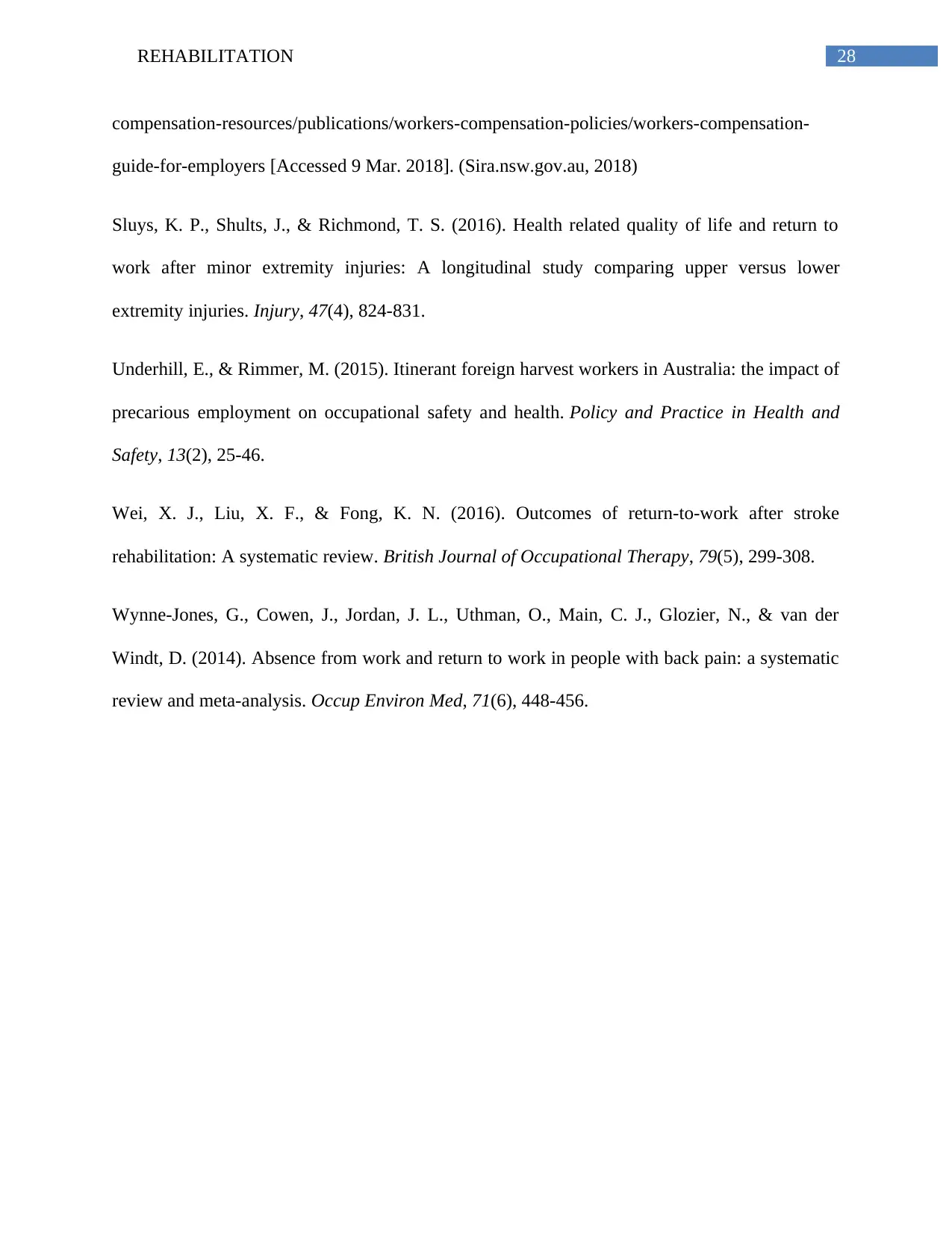
28REHABILITATION
compensation-resources/publications/workers-compensation-policies/workers-compensation-
guide-for-employers [Accessed 9 Mar. 2018]. (Sira.nsw.gov.au, 2018)
Sluys, K. P., Shults, J., & Richmond, T. S. (2016). Health related quality of life and return to
work after minor extremity injuries: A longitudinal study comparing upper versus lower
extremity injuries. Injury, 47(4), 824-831.
Underhill, E., & Rimmer, M. (2015). Itinerant foreign harvest workers in Australia: the impact of
precarious employment on occupational safety and health. Policy and Practice in Health and
Safety, 13(2), 25-46.
Wei, X. J., Liu, X. F., & Fong, K. N. (2016). Outcomes of return-to-work after stroke
rehabilitation: A systematic review. British Journal of Occupational Therapy, 79(5), 299-308.
Wynne-Jones, G., Cowen, J., Jordan, J. L., Uthman, O., Main, C. J., Glozier, N., & van der
Windt, D. (2014). Absence from work and return to work in people with back pain: a systematic
review and meta-analysis. Occup Environ Med, 71(6), 448-456.
compensation-resources/publications/workers-compensation-policies/workers-compensation-
guide-for-employers [Accessed 9 Mar. 2018]. (Sira.nsw.gov.au, 2018)
Sluys, K. P., Shults, J., & Richmond, T. S. (2016). Health related quality of life and return to
work after minor extremity injuries: A longitudinal study comparing upper versus lower
extremity injuries. Injury, 47(4), 824-831.
Underhill, E., & Rimmer, M. (2015). Itinerant foreign harvest workers in Australia: the impact of
precarious employment on occupational safety and health. Policy and Practice in Health and
Safety, 13(2), 25-46.
Wei, X. J., Liu, X. F., & Fong, K. N. (2016). Outcomes of return-to-work after stroke
rehabilitation: A systematic review. British Journal of Occupational Therapy, 79(5), 299-308.
Wynne-Jones, G., Cowen, J., Jordan, J. L., Uthman, O., Main, C. J., Glozier, N., & van der
Windt, D. (2014). Absence from work and return to work in people with back pain: a systematic
review and meta-analysis. Occup Environ Med, 71(6), 448-456.
1 out of 29
Your All-in-One AI-Powered Toolkit for Academic Success.
+13062052269
info@desklib.com
Available 24*7 on WhatsApp / Email
![[object Object]](/_next/static/media/star-bottom.7253800d.svg)
Unlock your academic potential
© 2024 | Zucol Services PVT LTD | All rights reserved.